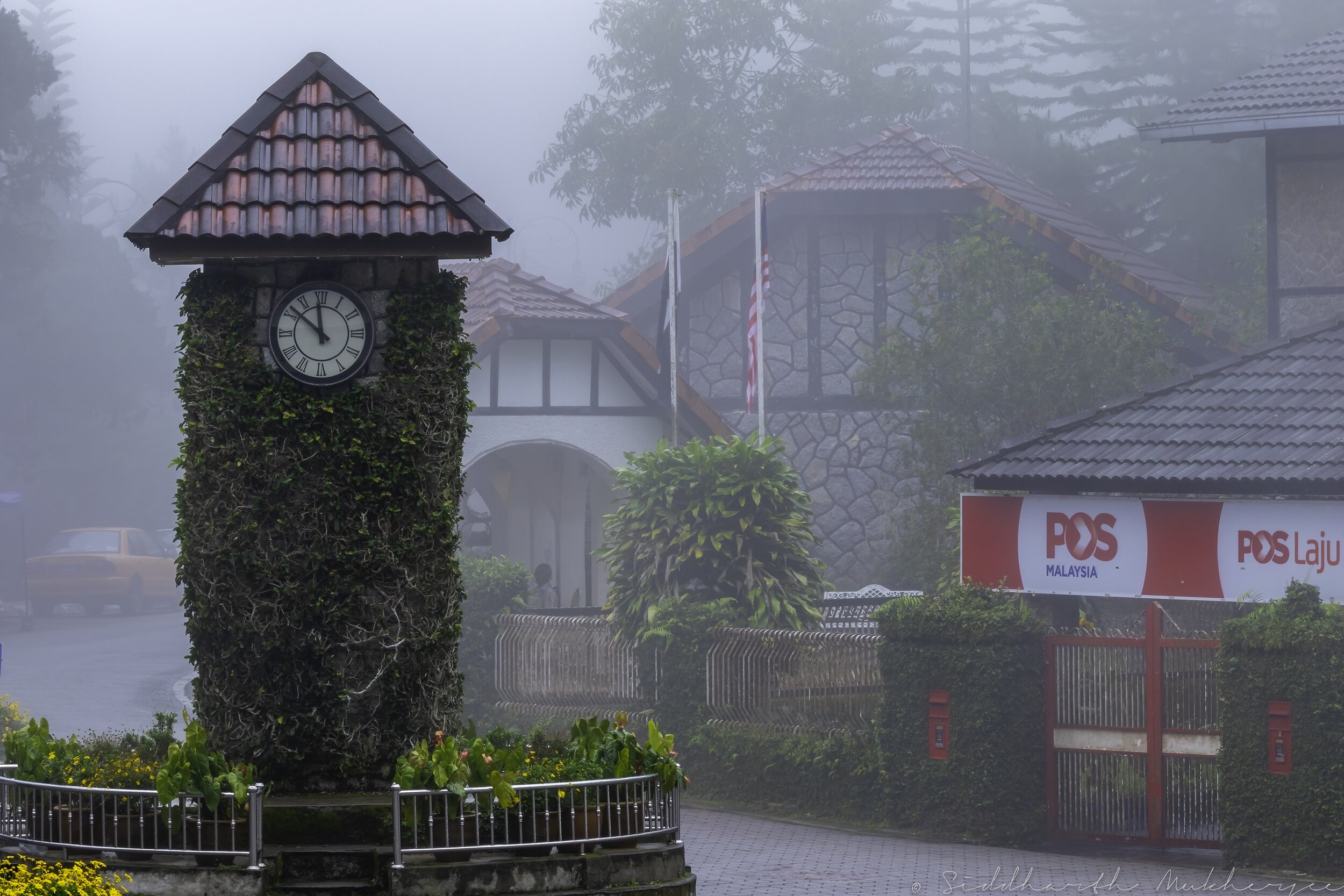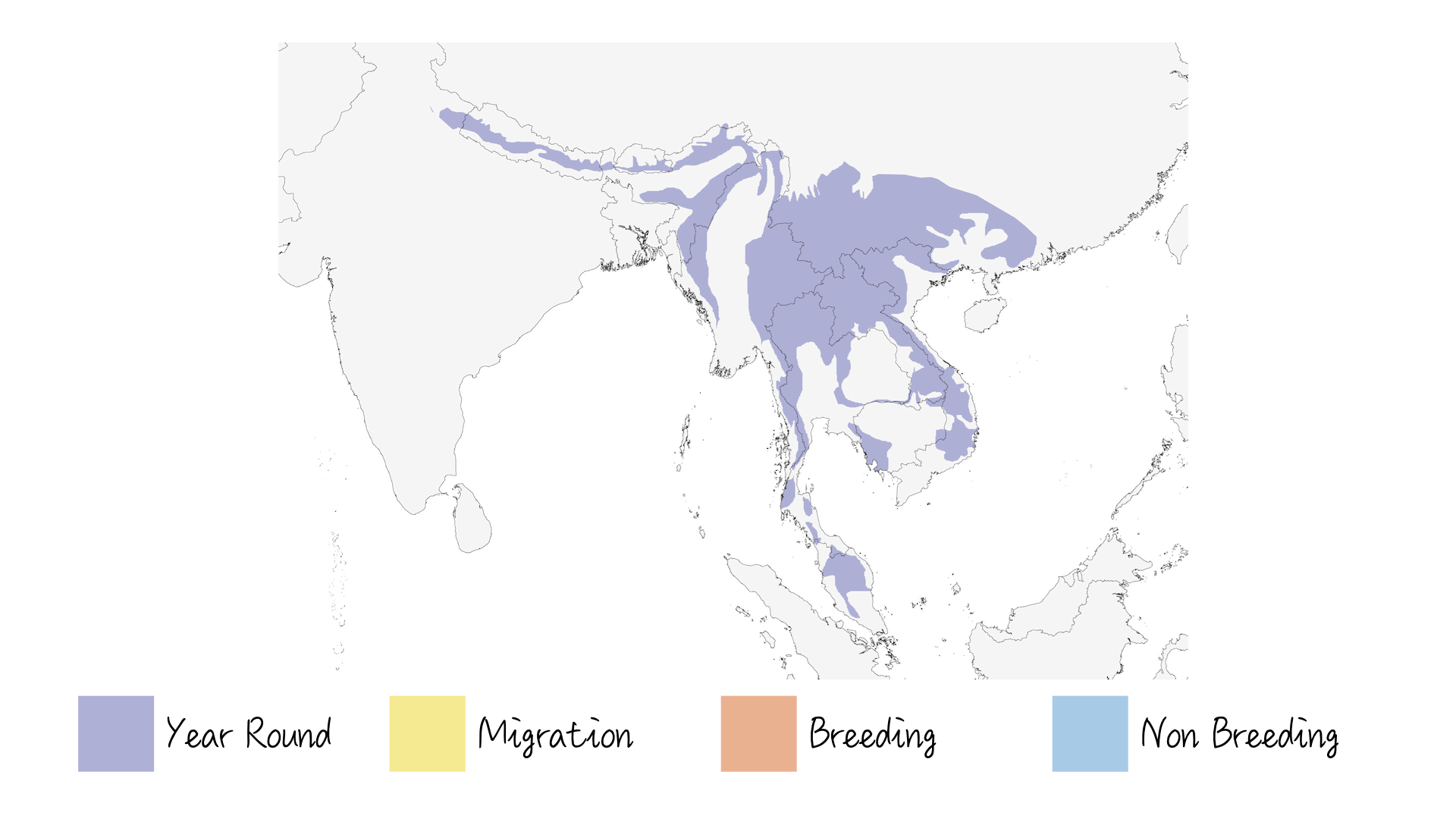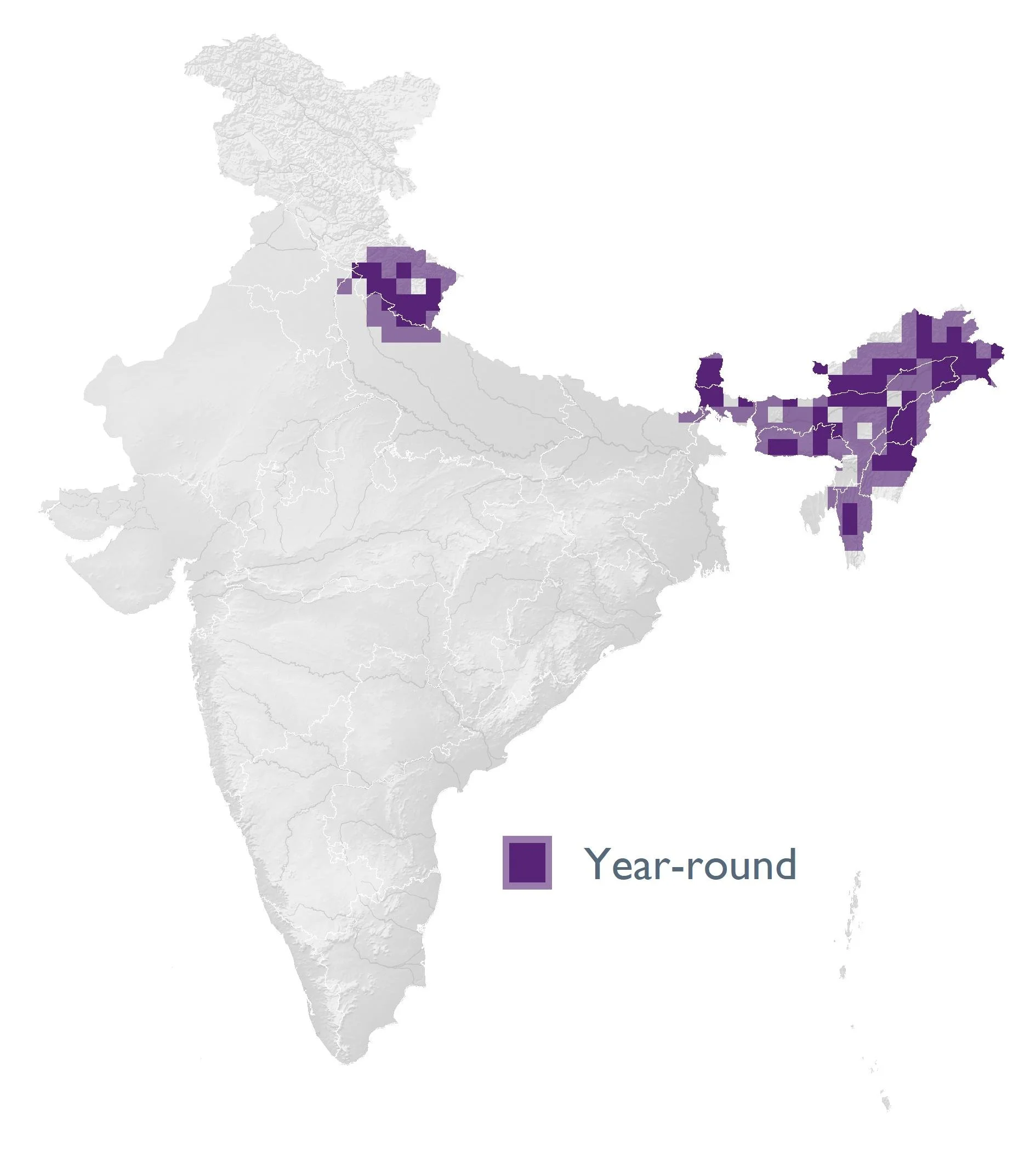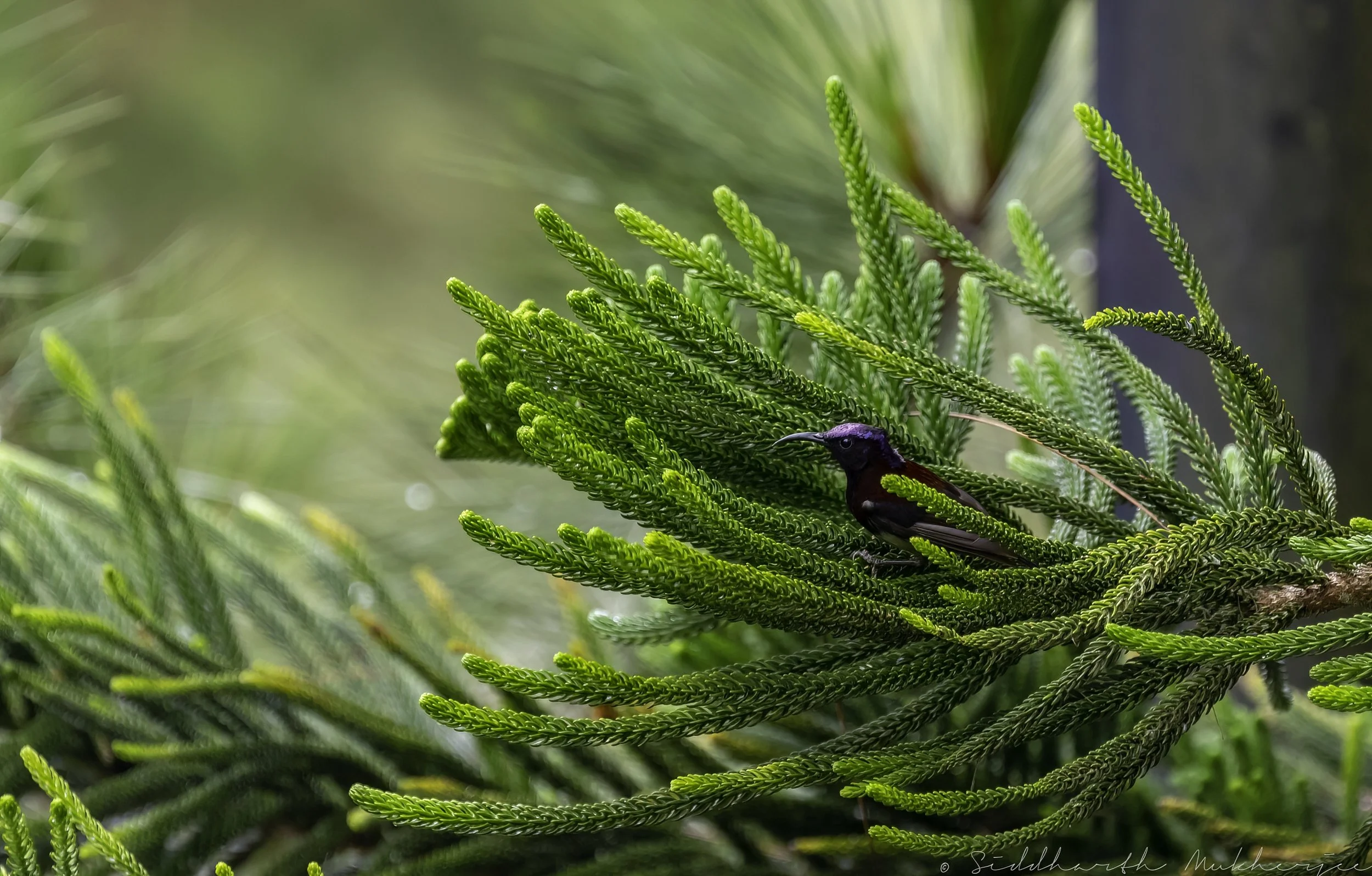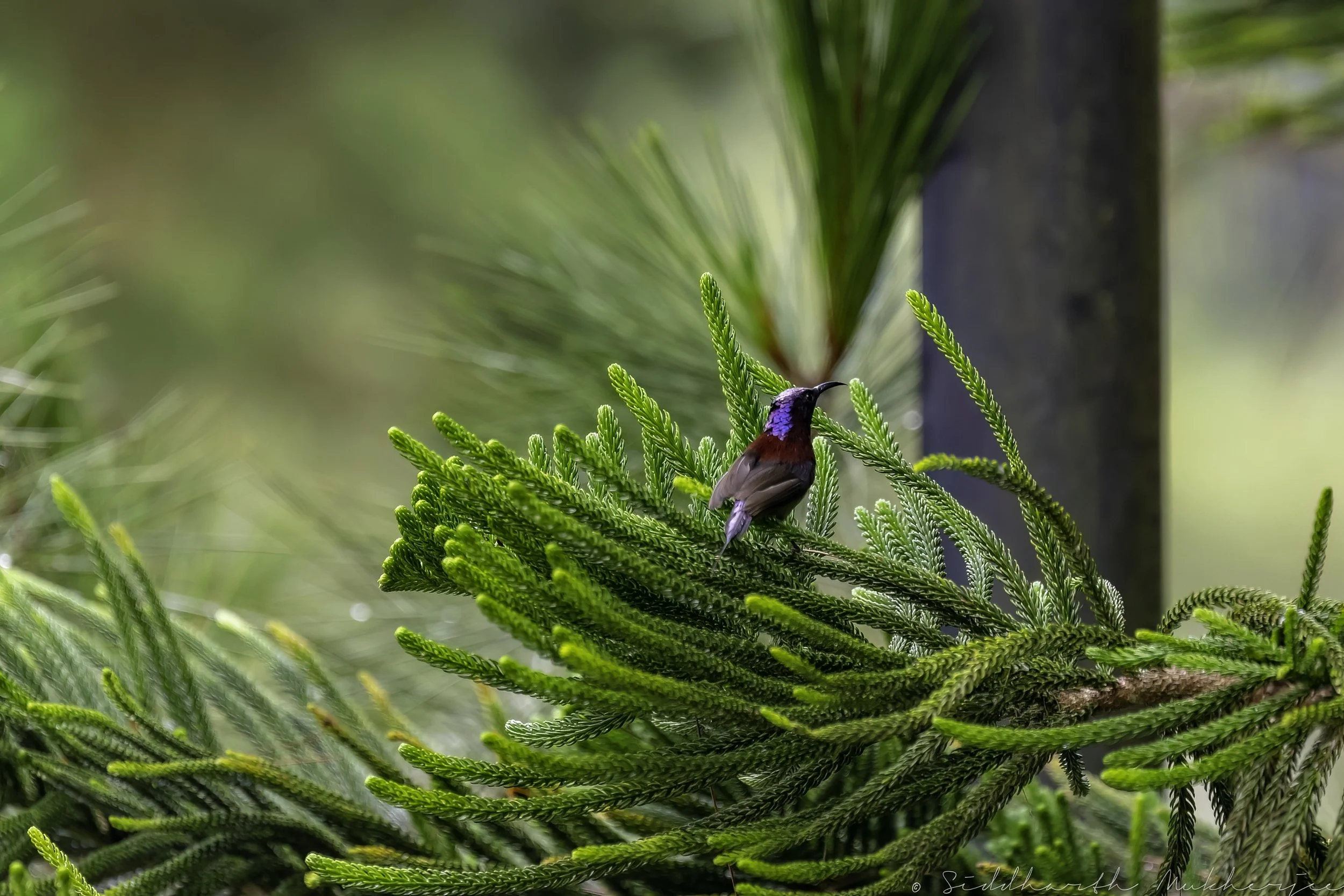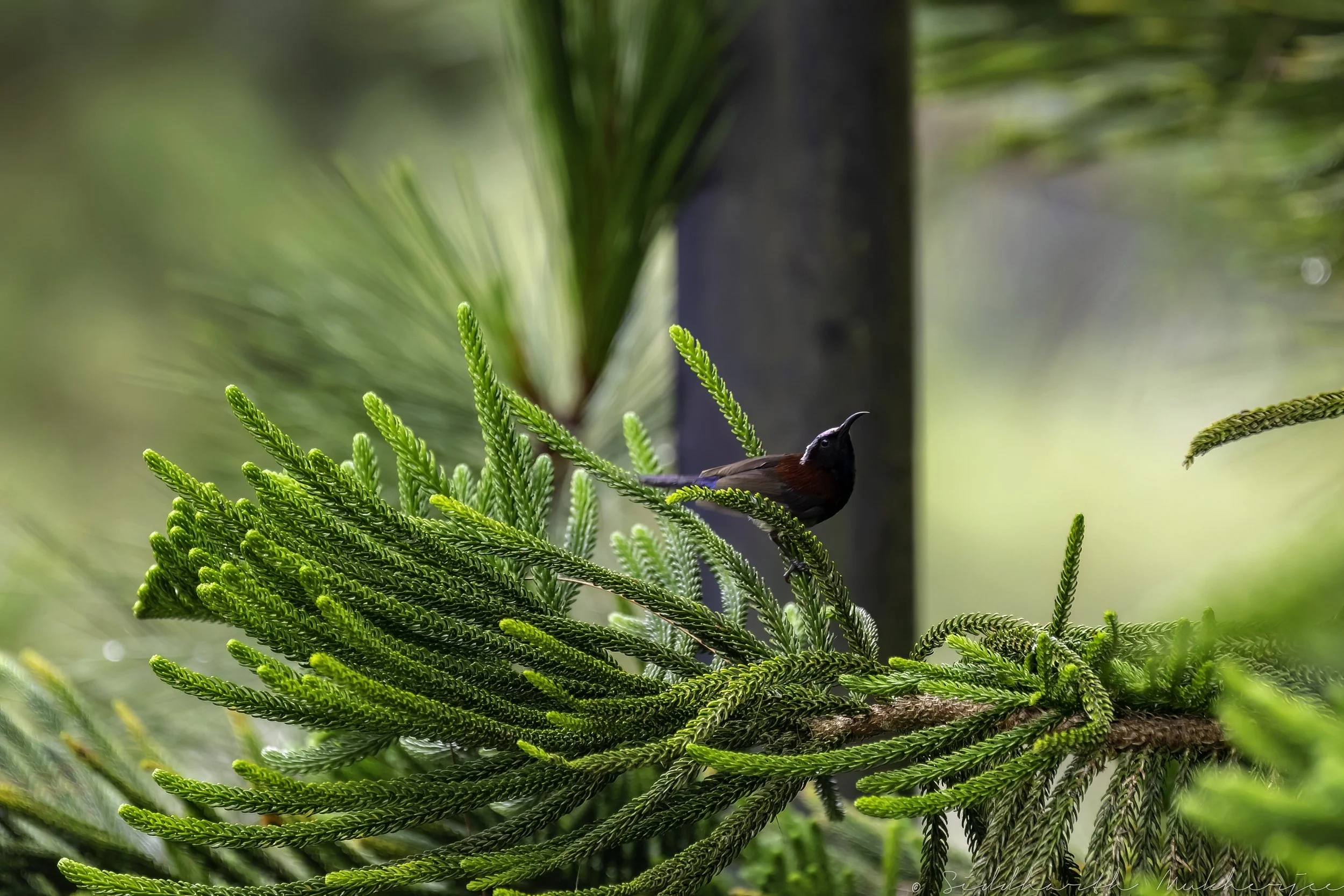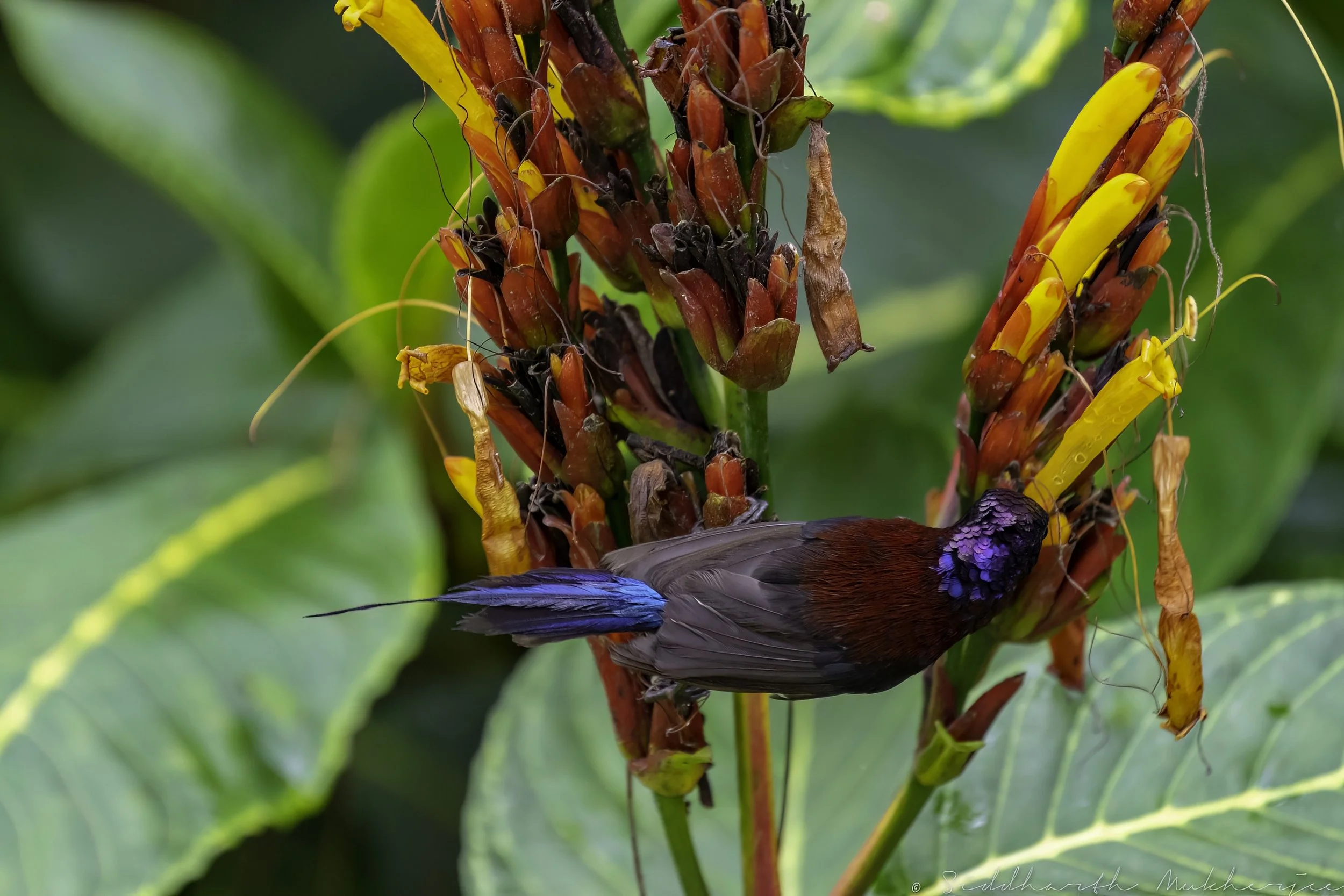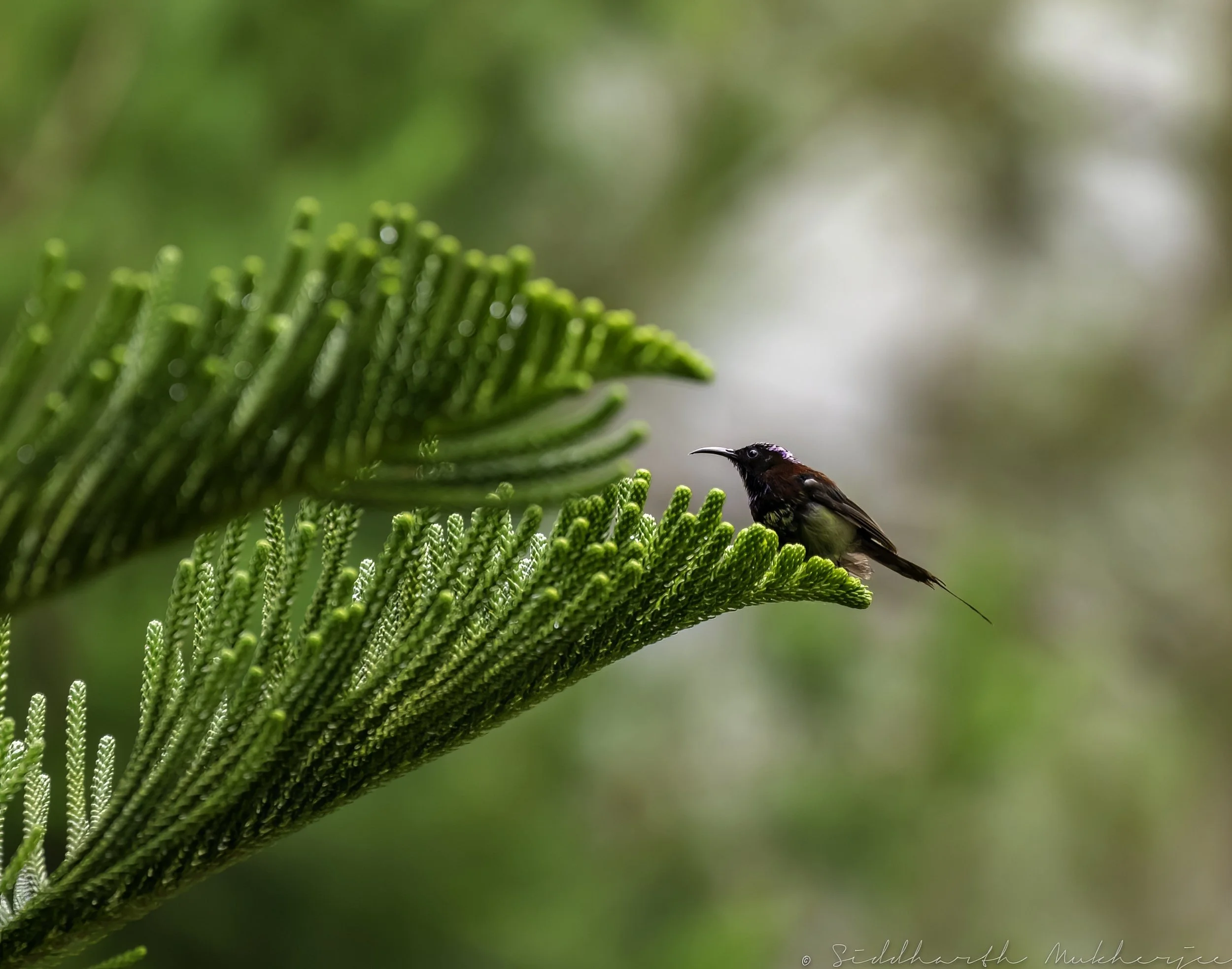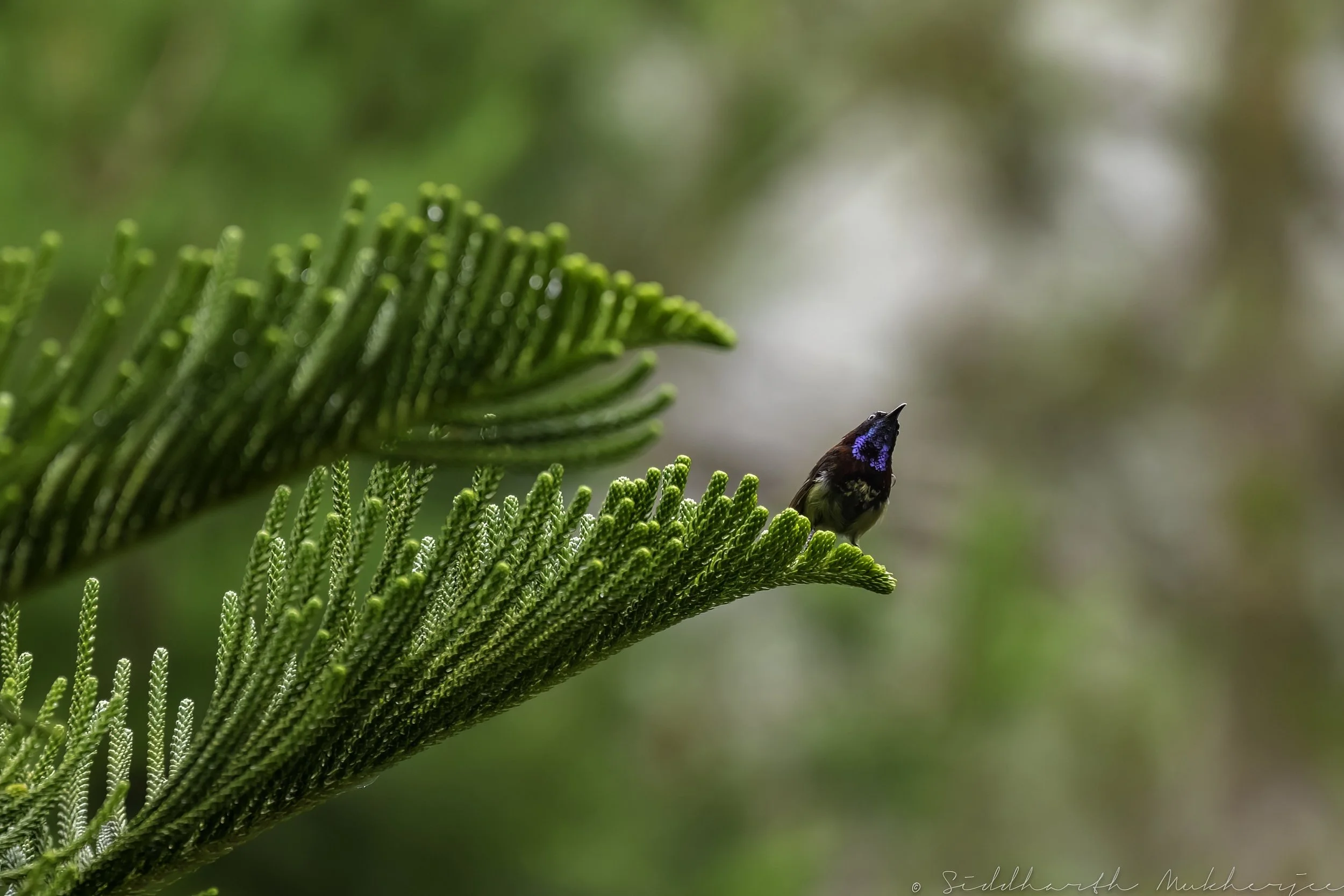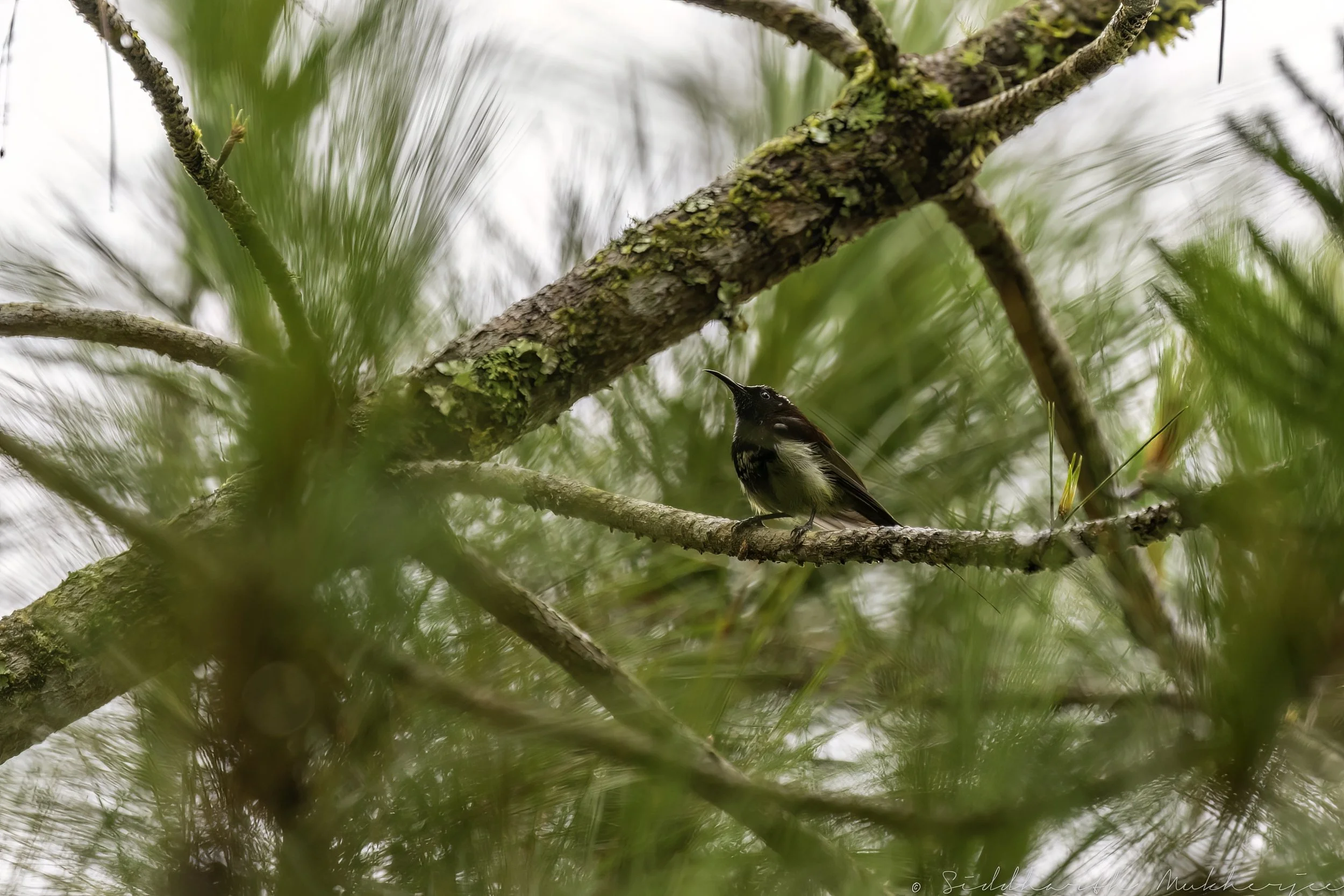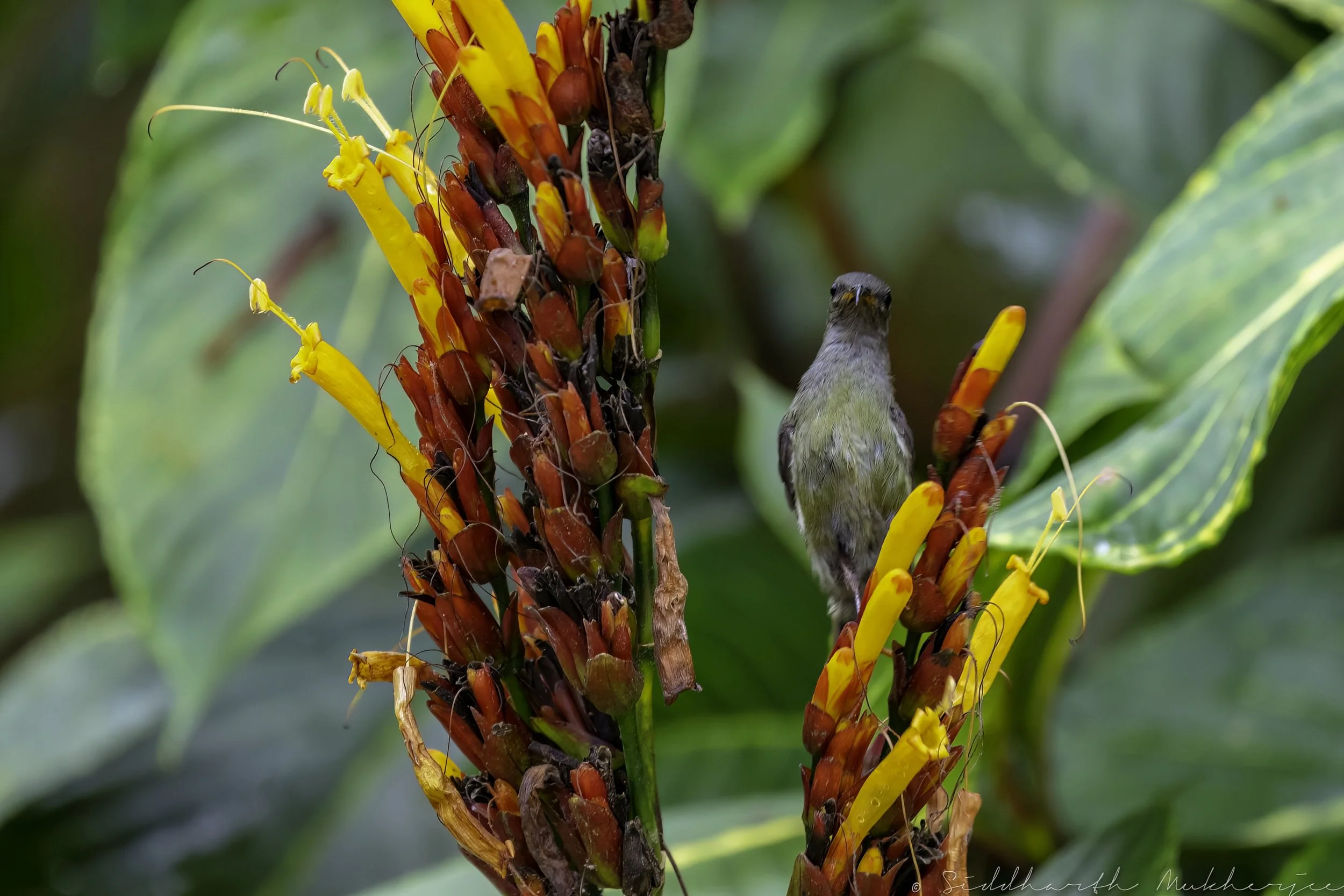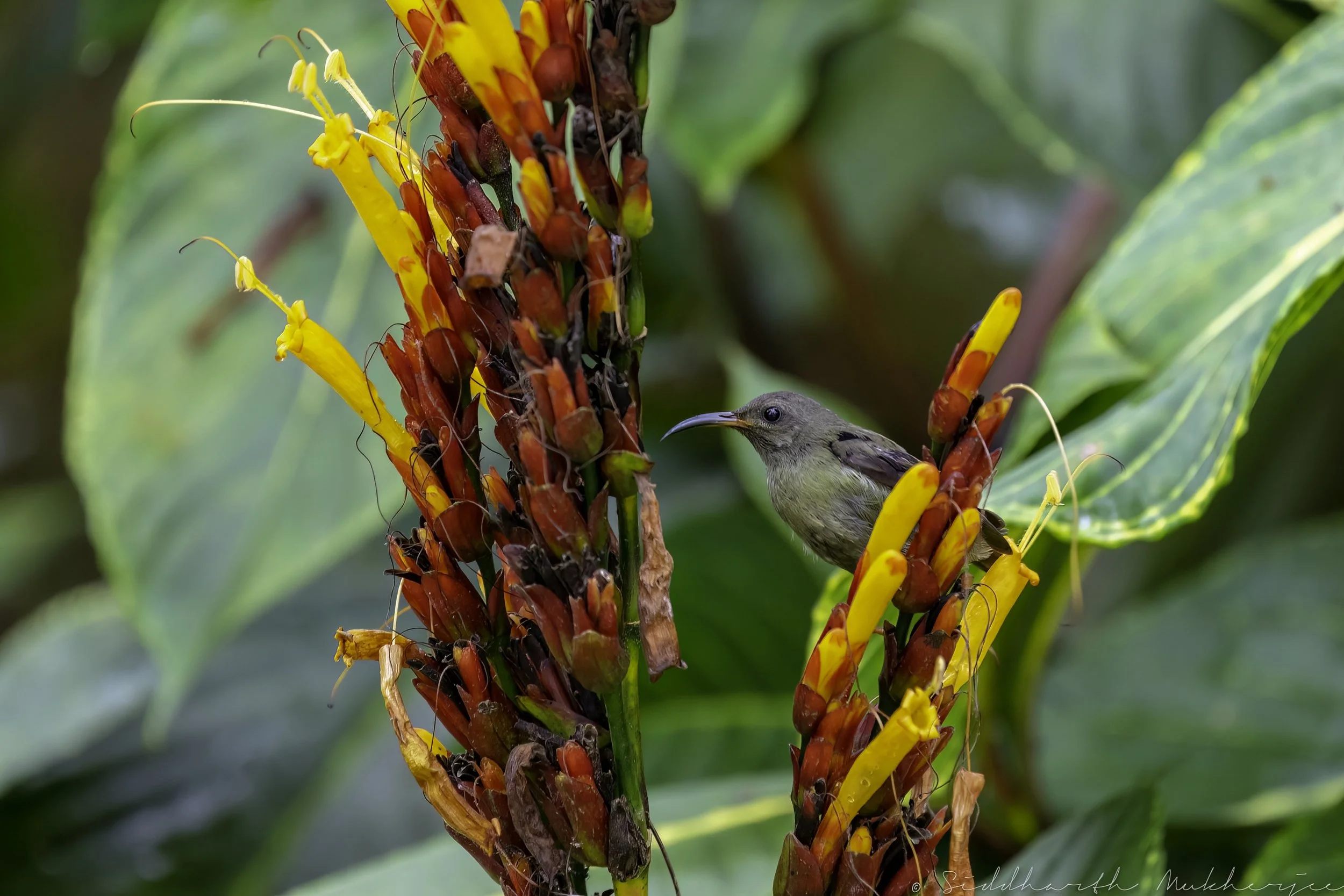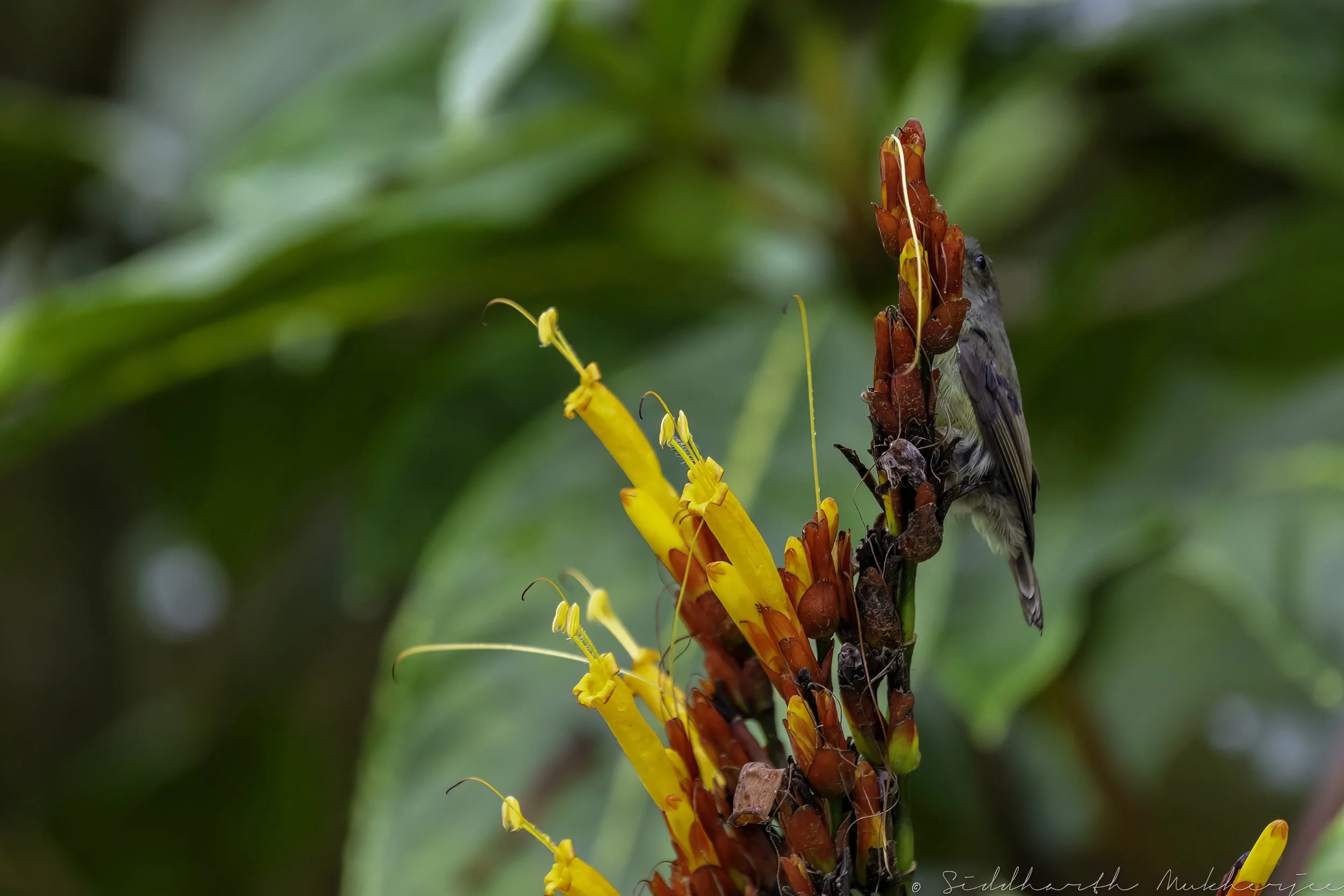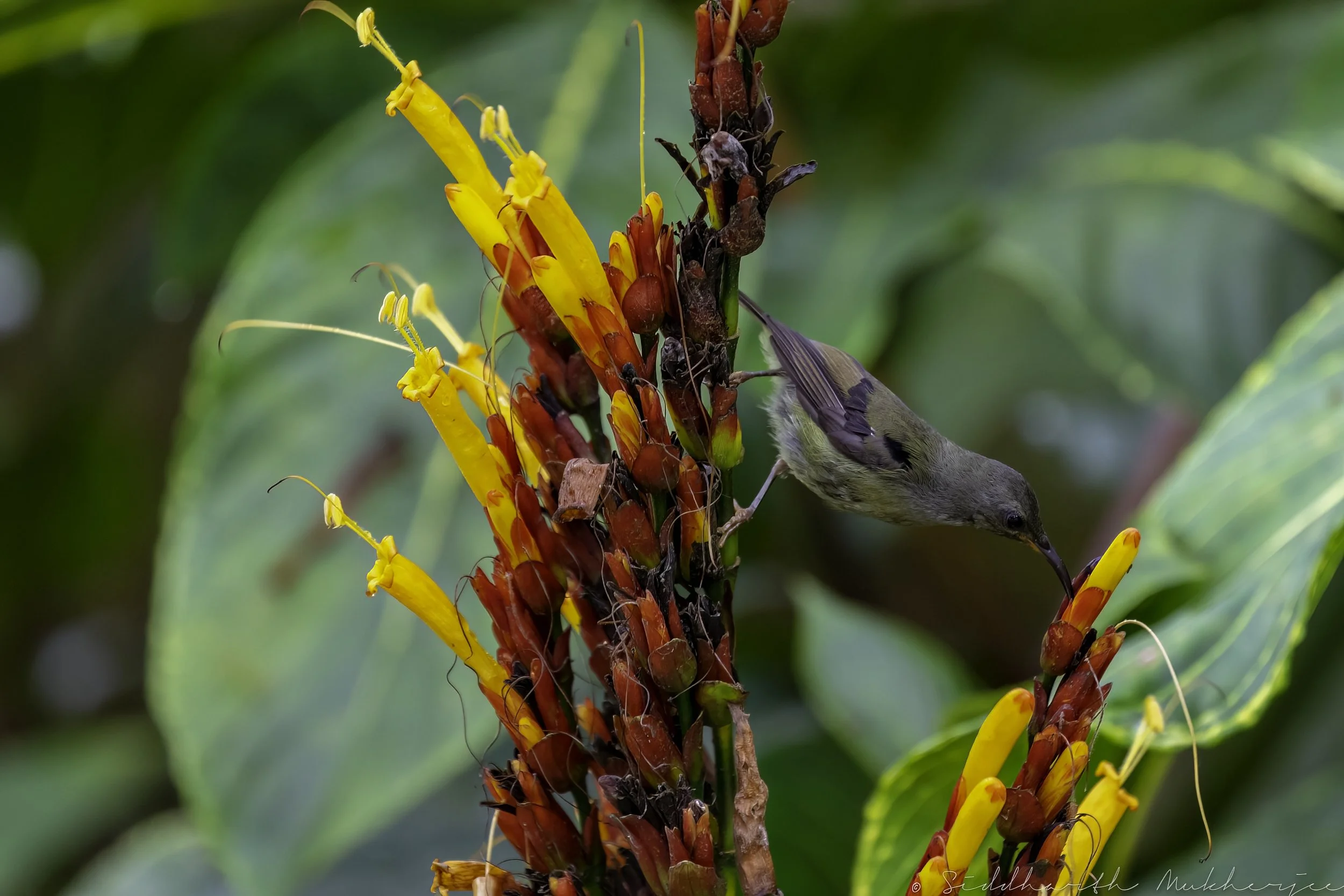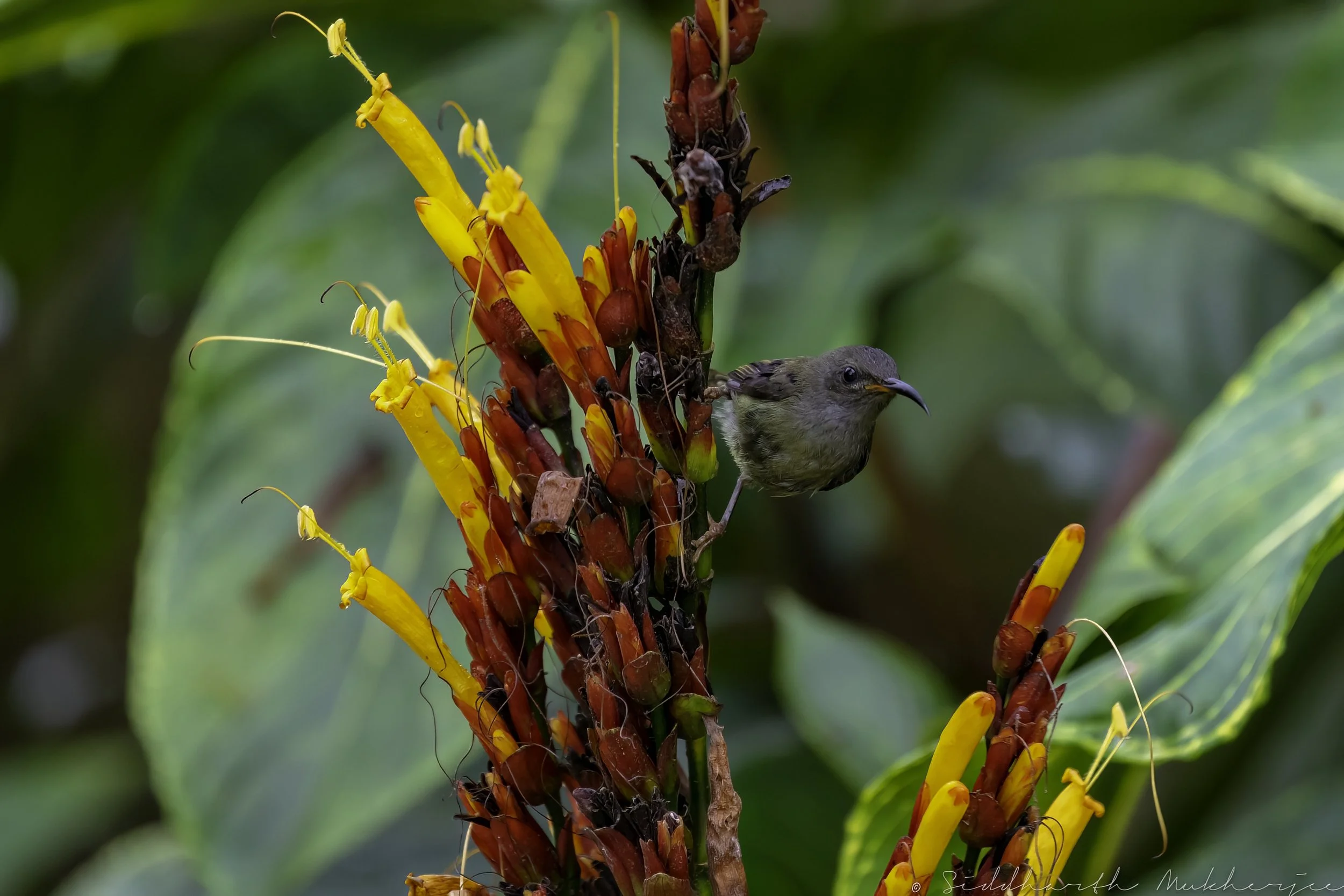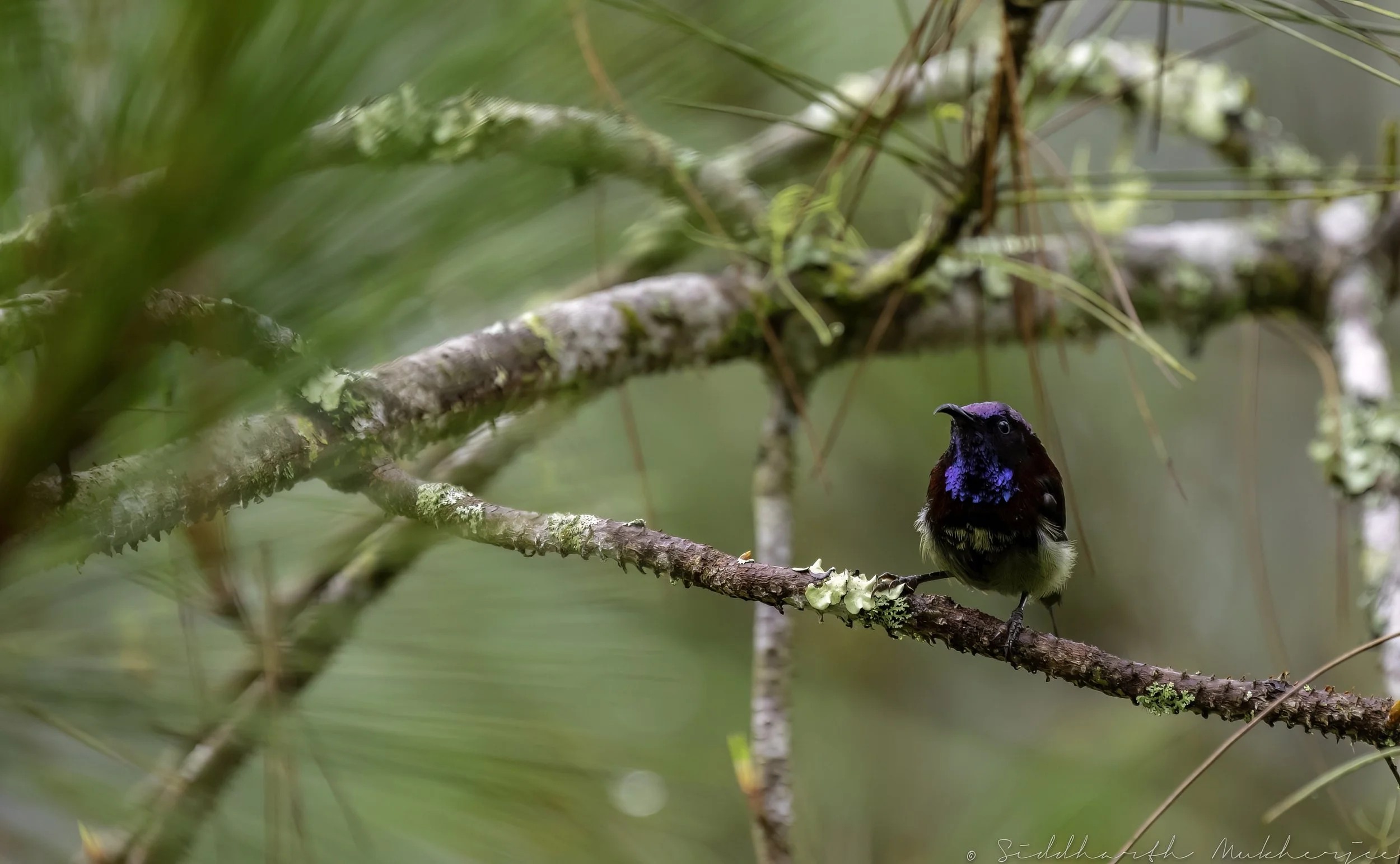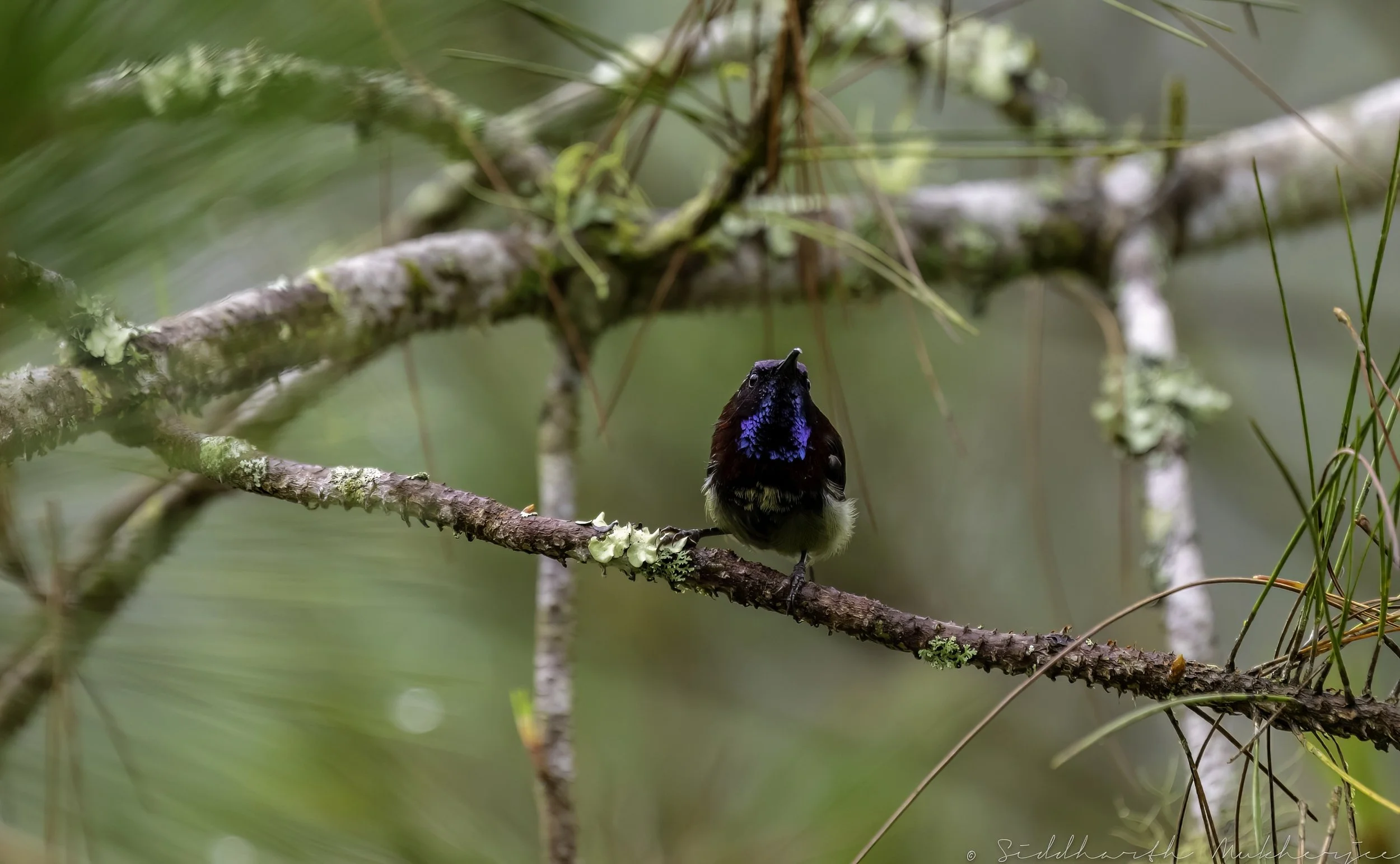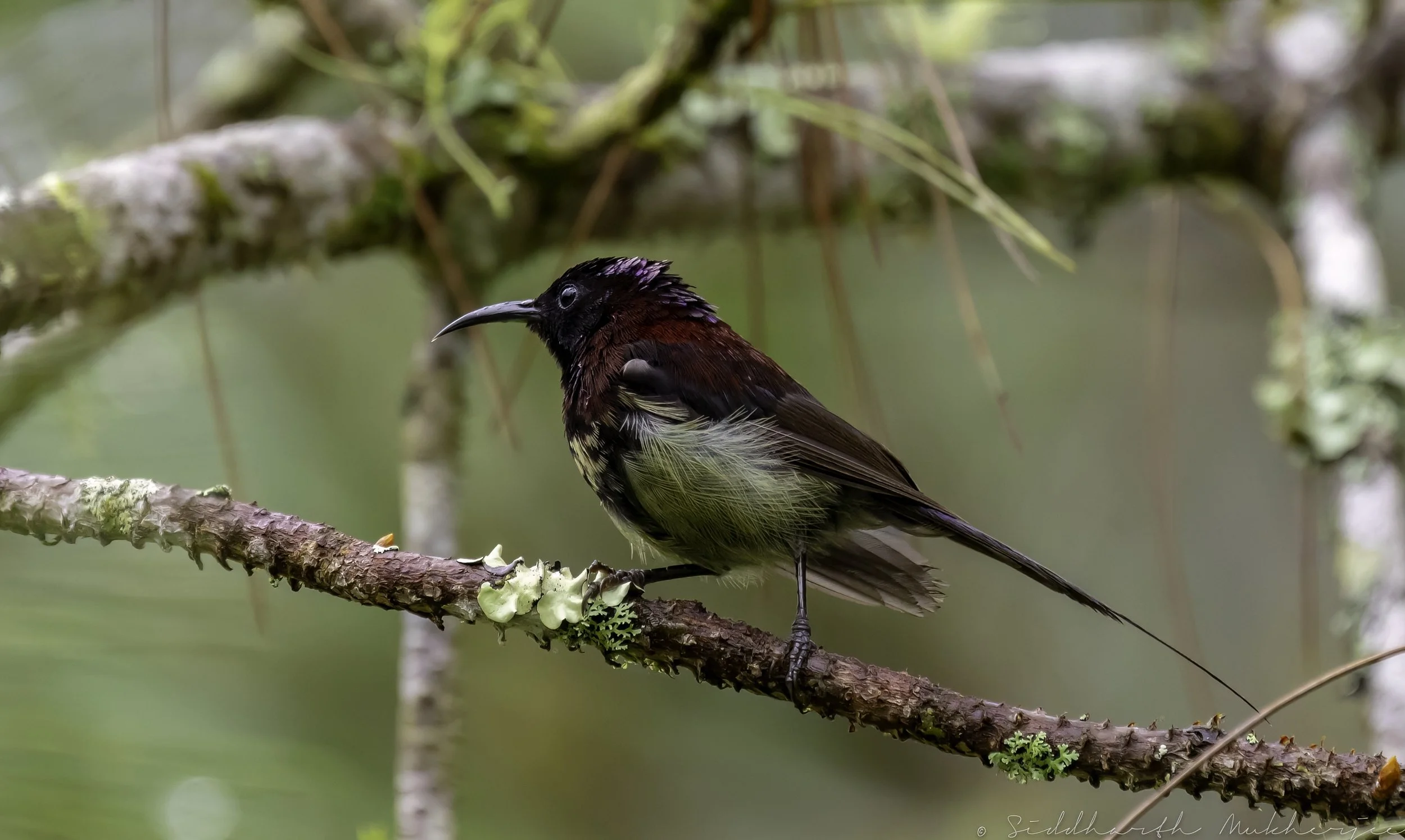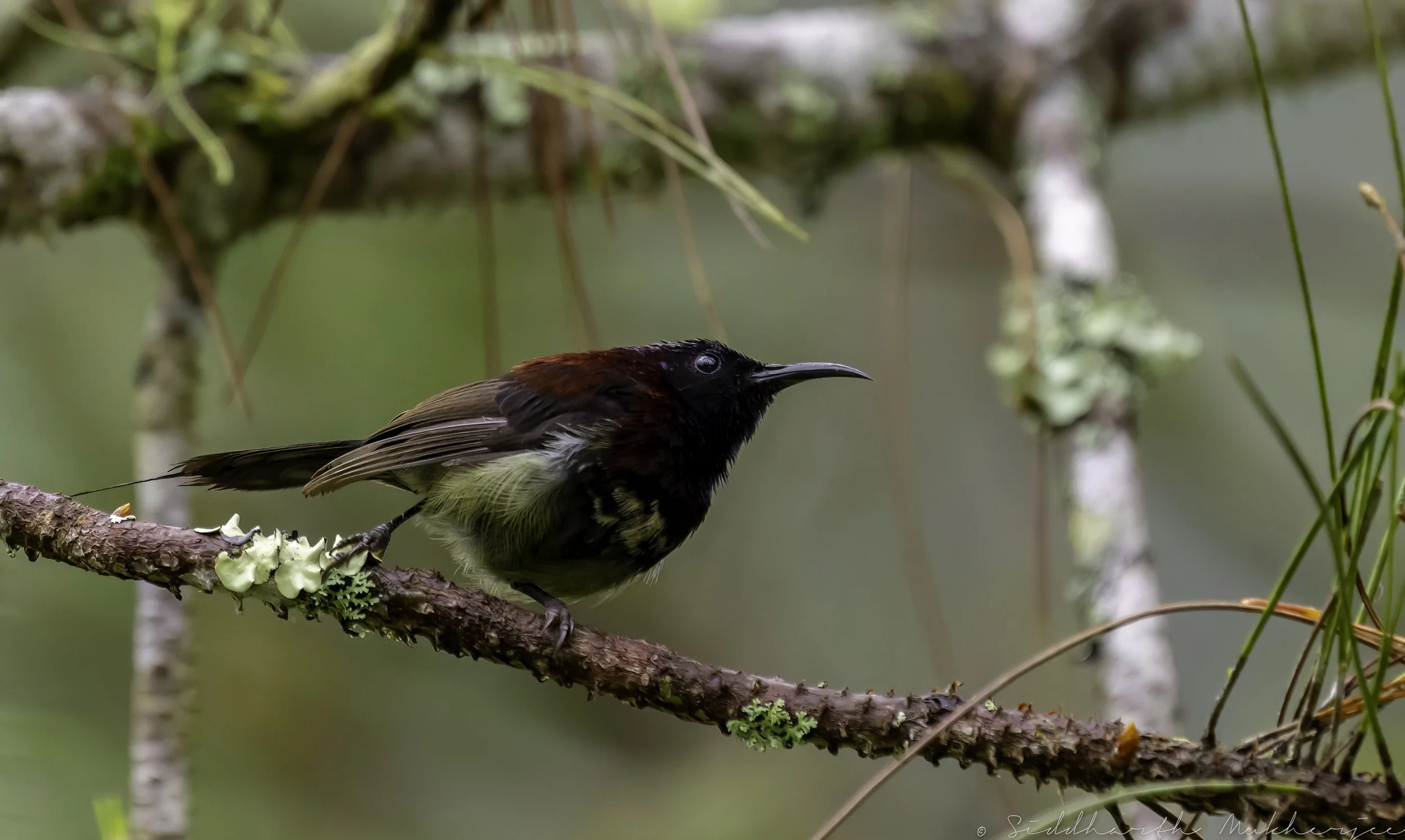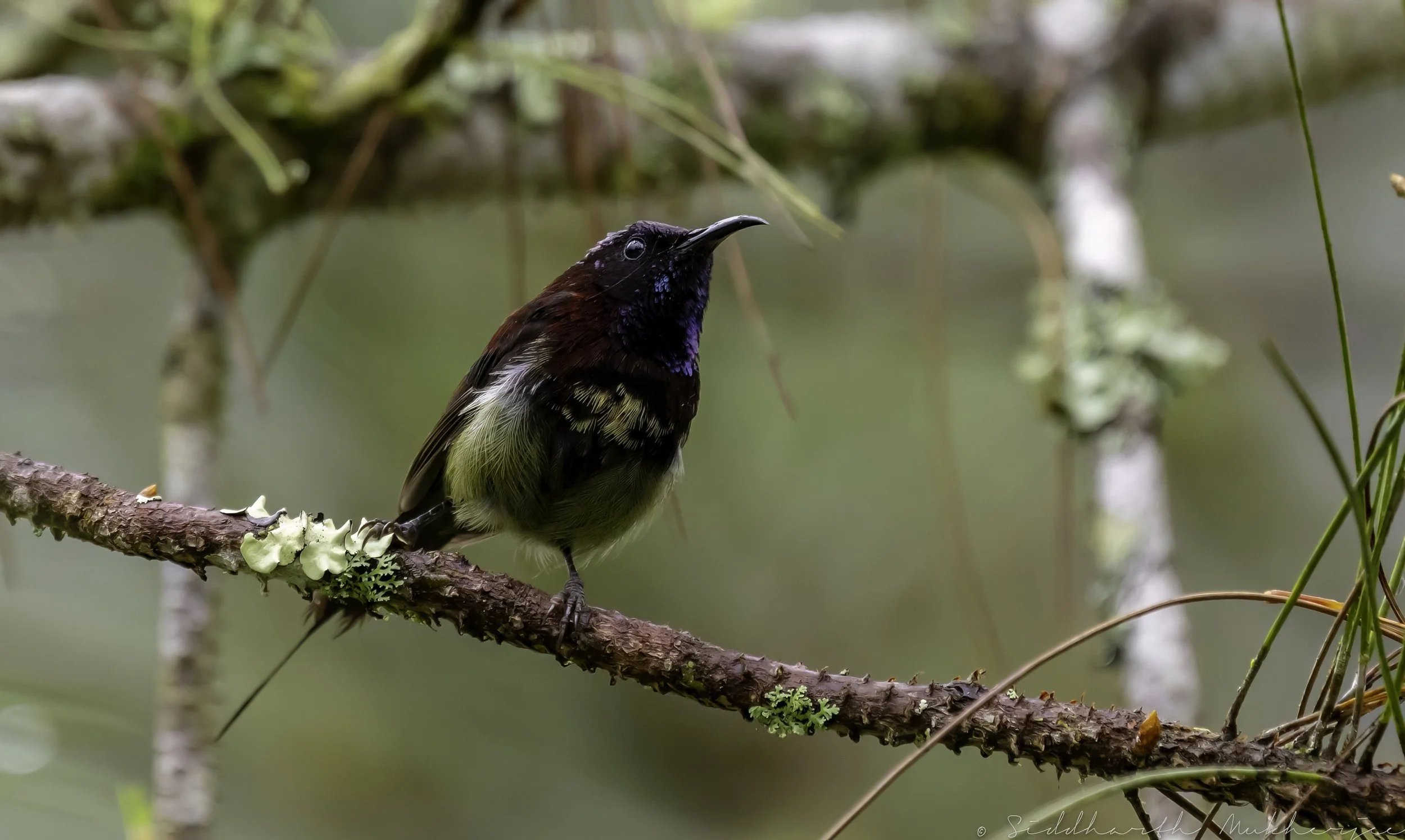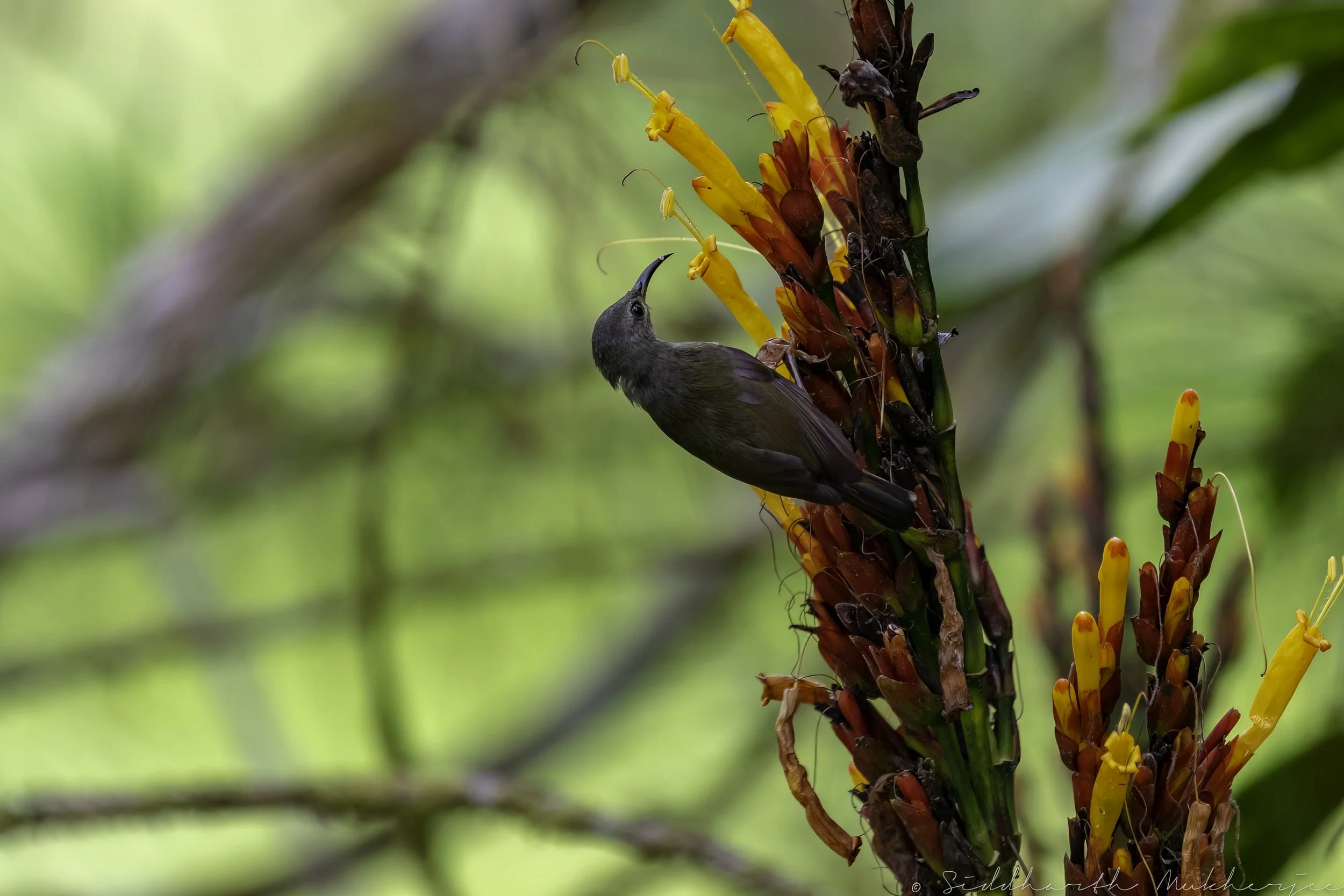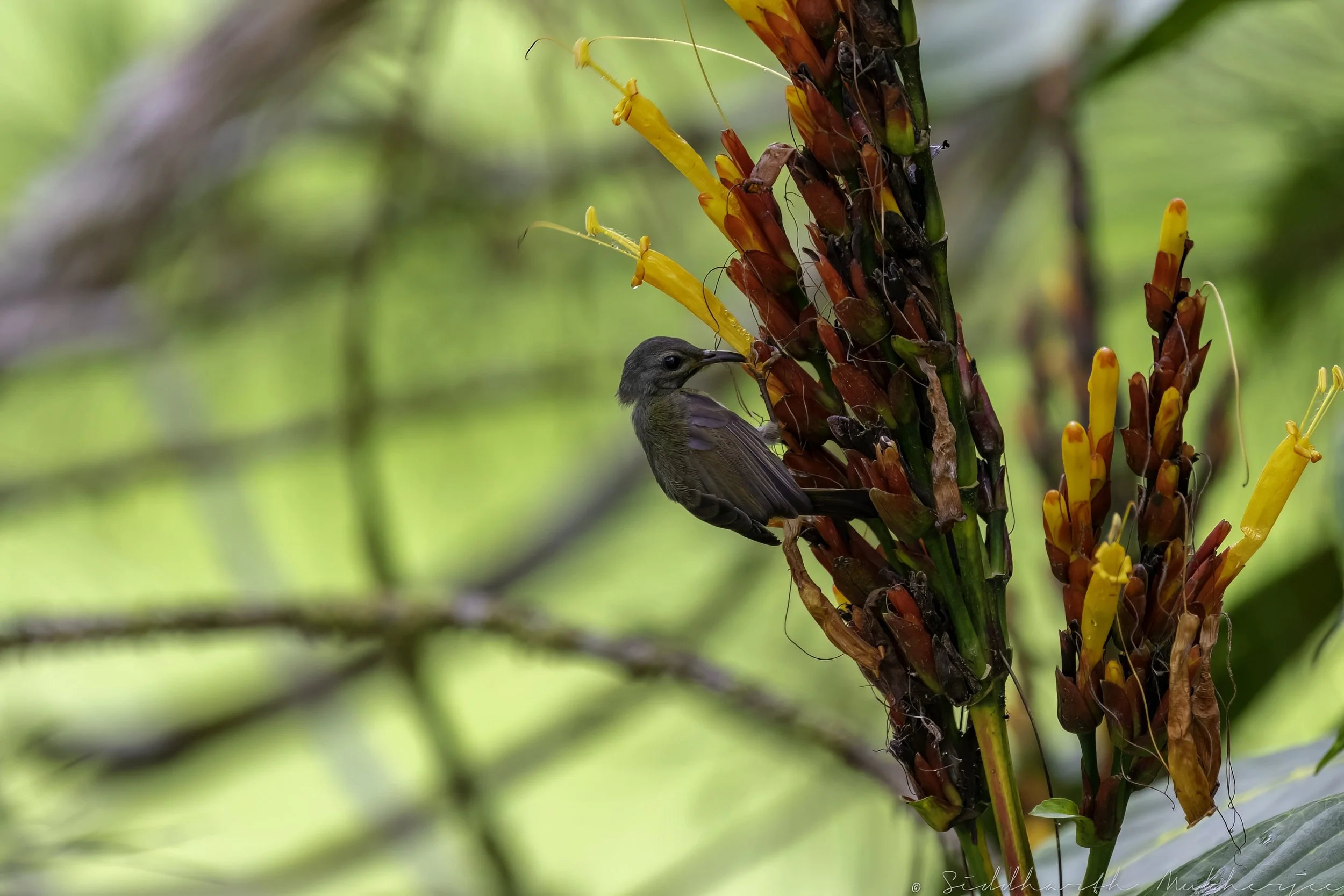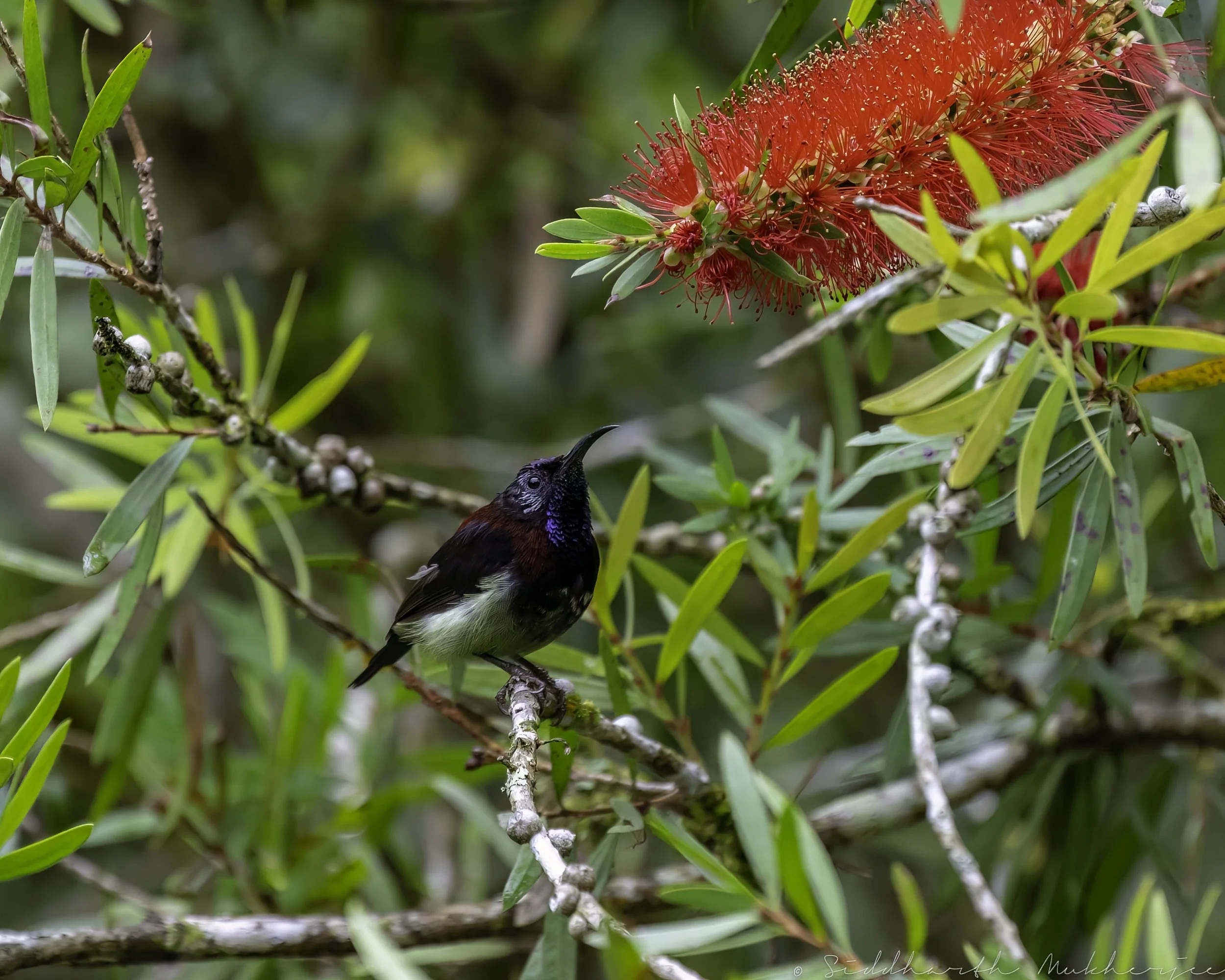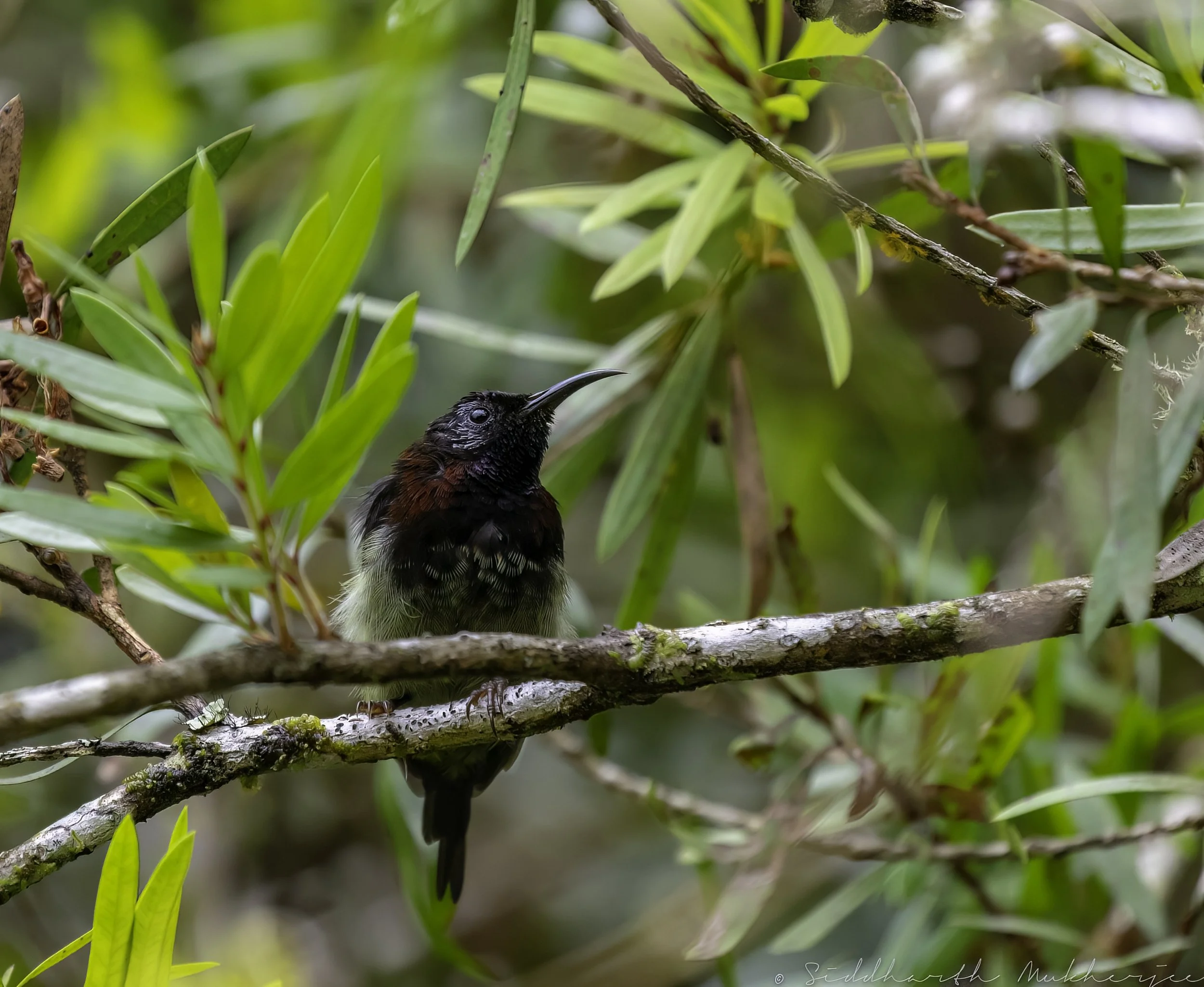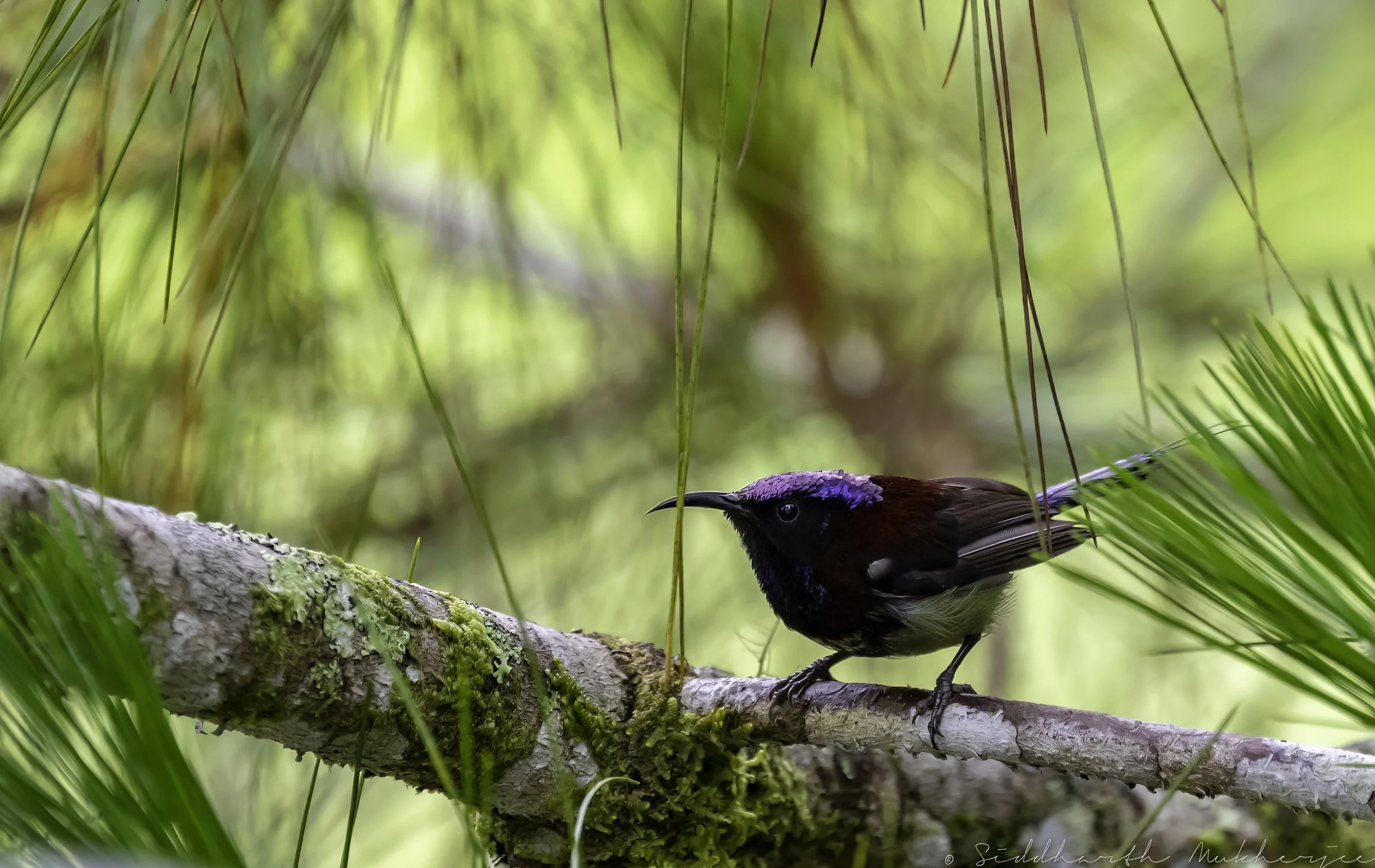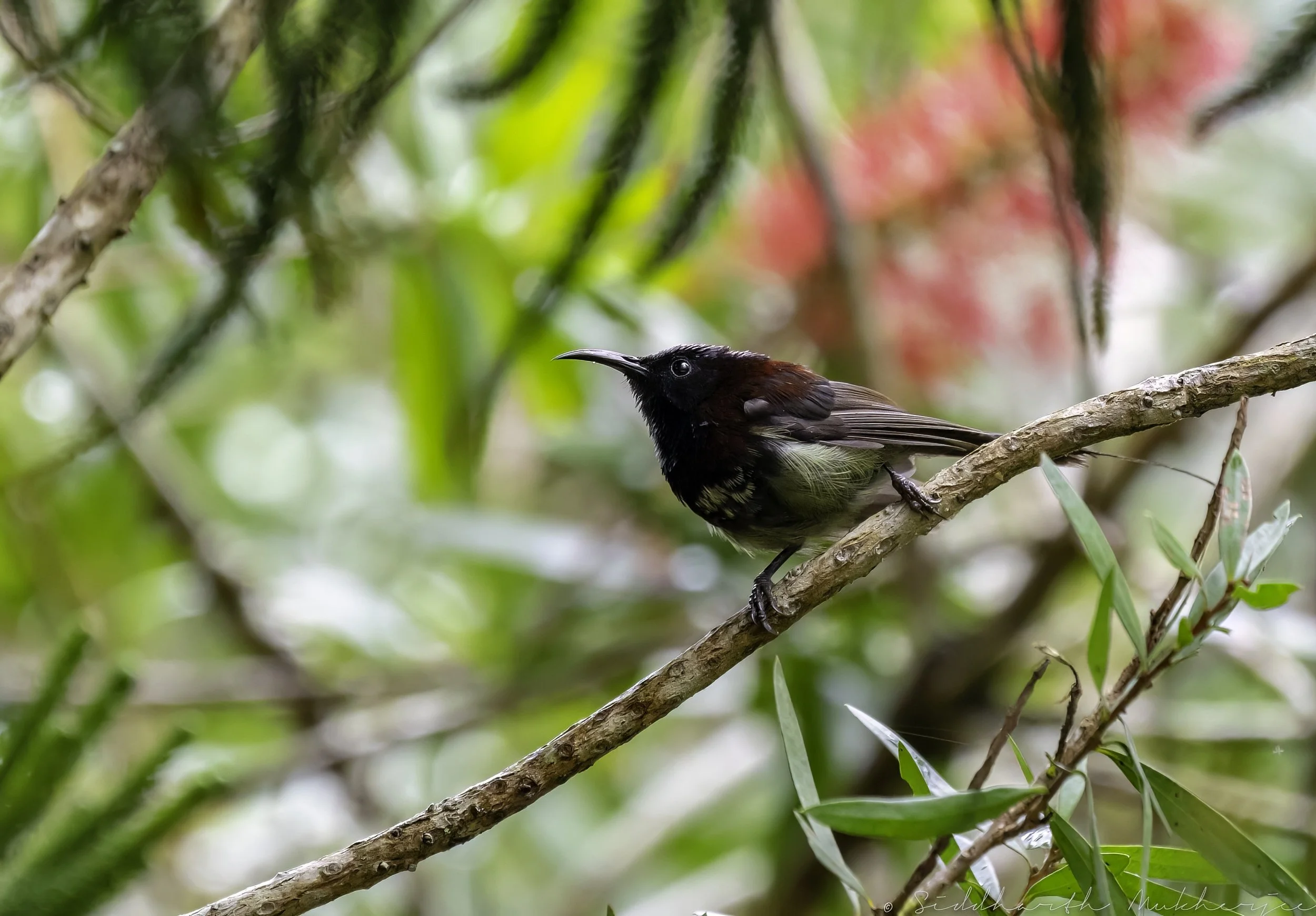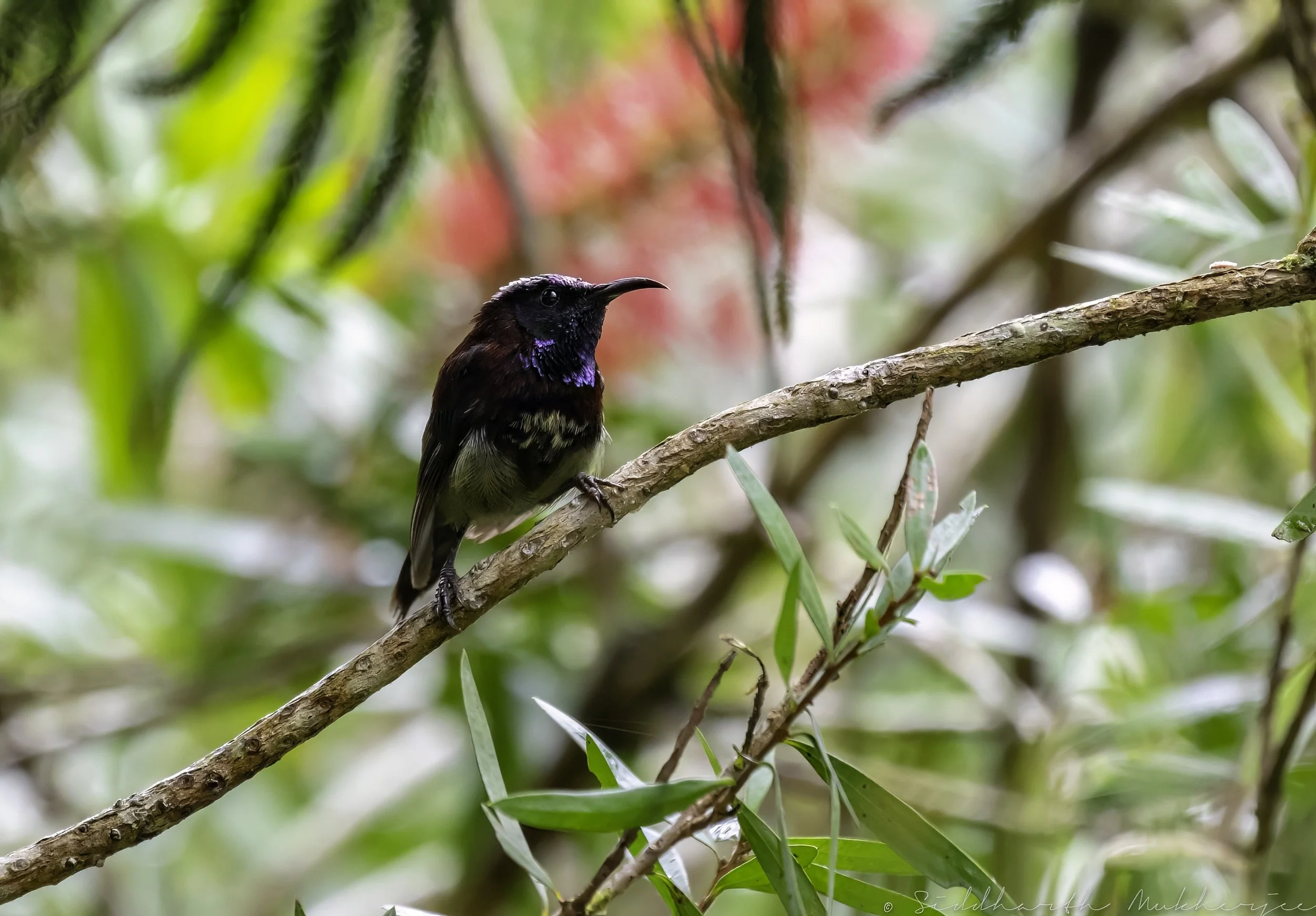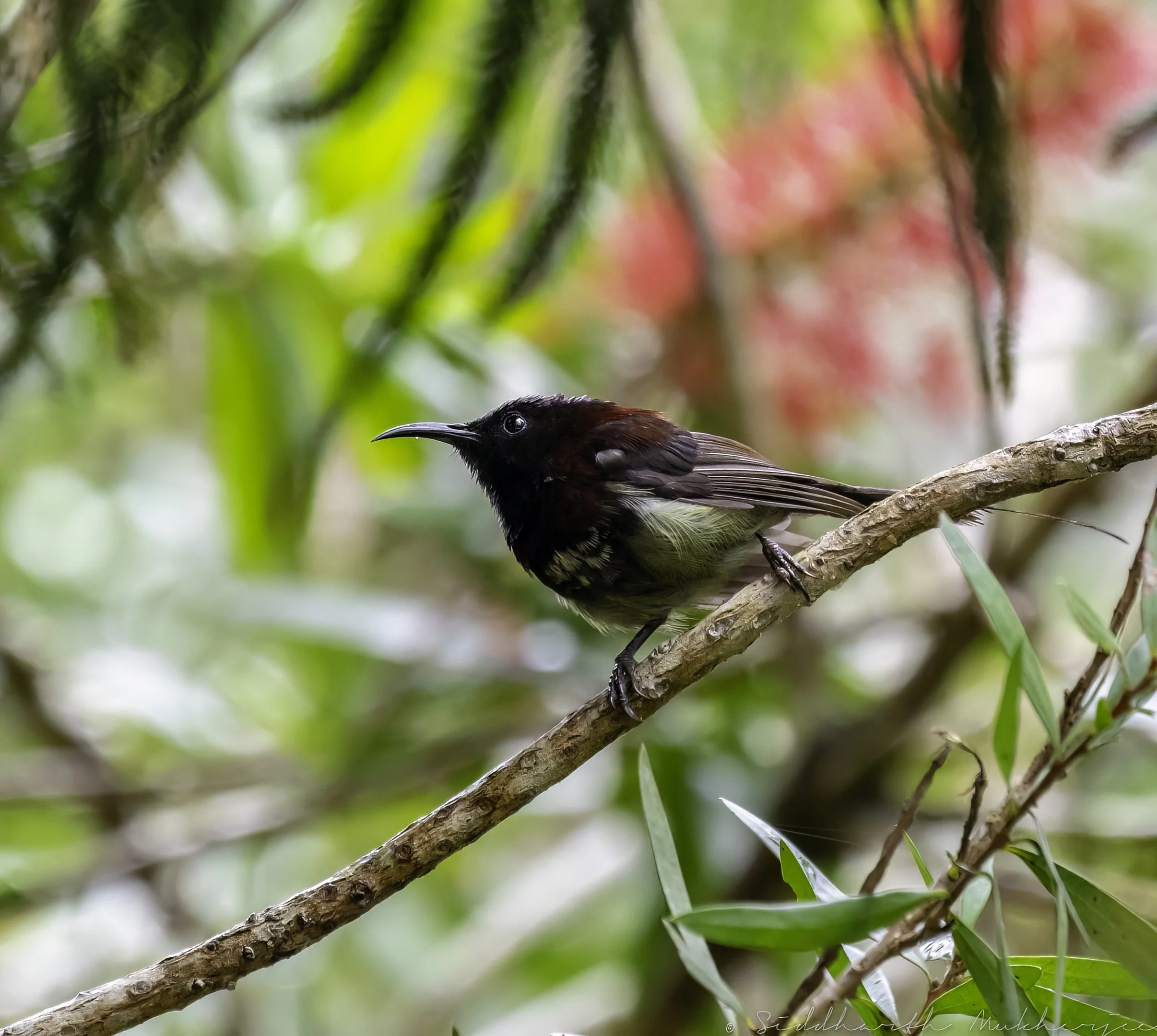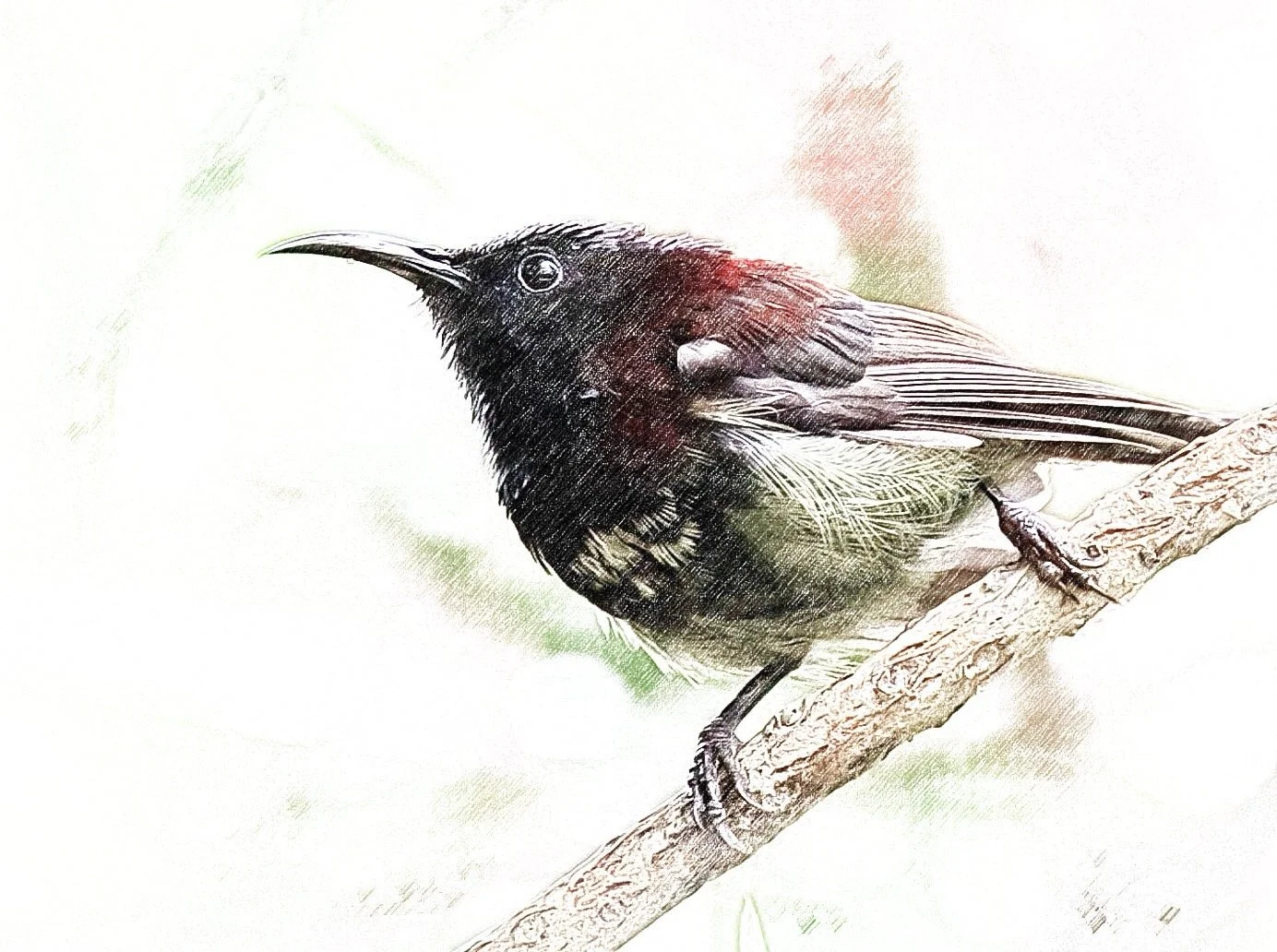Black-throated Sunbird
Aethopyga saturata
Bukit Fraser, Malaysia
Bukit Fraser is probably my favourite destination in Malaysia. Bukit Fraser or Fraser's Hill is a hill resort located on the Titiwangsa Ridge in the Raub District of Pahang, Malaysia. It is about 100 km, about a two hour drive, from the capital Kuala Lumpur and 400 km away from Singapore in the south. Known locally as Bukit Fraser, this quaint holiday retreat is popular for its nature activities and cool weather. It is one of the last hill stations of Malaysia carrying an imprint of its former British colonial masters very similar to some of the well known hill stations (winter capitals) of India.
From a birding perspective Bukit Fraser has also been very kind to me. Each time I have visited I have been blessed with numerous sightings and at very close proximity too. The mountainous terrain with altitude ranges between 320 m (1,050 ft) and 1,460 m (4,790 ft) above sea level is home to diverse species and if one has the patience there are innumerable moments one can document. Around 44% of the terrain area is ranked as steep, while flat areas make up 8% of the overall land area. Fraser's Hill's virgin forest coverage is around 92% of the overall land area, with only 1.5% of the area used for a town. 6.5% of the forest area has been cleared for secondary vegetation. Ten river systems in Malaysia originate in Fraser's Hill, including Sungai Selangor, a major water source for the district of Selangor, & Sungai Teranum, which forms a major river system in eastern Pahang. The geology of the area is granite, which forms sandy, permeable soil and is easily eroded. This is very similar to the terrain one finds in and around Latpanchar, Mahananda Wildlife Sanctuary and also where the Black-throated Sunbird can be easily seen.
Mahananda Wildlife Sanctuary is located on the foothills of the Himalayas, between the Teesta and Mahananda rivers. Situated in the Darjeeling district of West Bengal, India; it comes under Darjeeling Wildlife division and can be reached from Siliguri in 30 minutes. Sukna, the gateway to the sanctuary, is only 13 km from Siliguri and 28 km from Bagdogra airport. The sanctuary sprawls over 159 km² of reserve forest and was started as a game sanctuary in 1955. In 1959, it got the status of a sanctuary mainly to protect the Indian Bison and royal Bengal tiger, which were facing the threat of extinction.
Bukit Fraser
Fraser’s Hill has its roots in the 1890s, when Scottish prospector Louis James Fraser opened up a tin mining community known as Pamah Lebar. Mining activity there was short lived as the tin ore depleted by 1913. This led many miners and farmers to abandon the area and Fraser reportedly disappeared in 1910, but research in 2019 concluded that he retired from his position and returned to Great Britain in 1910. He died in 1916 while travelling in Austria-Hungary. An attempt in 1917 by Charles James Ferguson-Davie, the then bishop of Singapore, to locate Fraser in the area failed. While he searched for Fraser, Ferguson -Davie recognized the area's potential as a suitable location to set up a hill station and provided his suggestions to the high commissioner and chief secretary of the Federated Malay States. Its cool climate made Pamah Lebar an ideal retreat to escape from the usually hot climate in Malaysia and construction began in October 1919 to convert the mine area into a resort. The site was renamed Fraser's Hill and opened to visitors in 1922 and the erstwhile location of Fraser’s tin mine became the location of its golf course.
Subsequent development occurred in the 1970s in response to increased tourism activity. While this provided room for more visitors, it had an impact on the environment including deforestation and water pollution prompting a halt to further developments in April 2010. More species faced extinction and the water pollution affected the lives of the Orang Asli (first people) and residents in nearby villages. These issues led to the Pahang state government ruling out further development in the virgin forest at Fraser's Hill on 13 April 2010.
Fraser's Hill is known for its vast biodiversity which attracts scientists and researchers. In recent years, it has seen an increase in tourist activities including hiking, cycling, golfing, archery, riding, tennis, swimming and squash. With its tiny population of 1,000, as recorded in 2013, it is one of Malaysia’s most unexpectedly satisfying short-stay destinations. Navigating up the tight twists and turns of the road to this hill station is a stimulating experience – in fact the uphill road is so narrow that the final eight kilometre stretch is limited to one-way traffic at any time. The direction changes every hour; odd hours are for ascending the hill, while even hours have been denoted for descending traffic. With a majority of its buildings featuring mock Tudor-style architecture, Fraser’s Hill hasn’t changed much from its days as a British colonial hill resort. Besides the essential photo stop opportunity at Fraser’s Clocktower, a hard-to-miss clock tower which stands in the old English village square, you can head on down to Allen’s Water, a former reservoir turned into a boating and fishing attraction.
Read about some of the birds I have photographed at Bukit Fraser.
Akin to a tiny Scottish hamlet, Fraser’s Hill is one of Malaysia’s premier locations for bird-watching. Avid bird watchers can take advantage of the fact that Fraser’s is home to over 250 species of birds – the Fraser’s Hill Development Corporation and the World Wildlife Fund both run classes and excursions to see the flora and wildlife of the hill station. What's more, the Fraser’s Hill International Bird Race – a contest to document the vast variety of birdlife on the mountainside – is typically held here in June. There are eight nature walk trails available ranging from easy to hard. For example the Maxwell Trail – a short and easy hike or the six-kilometre Pine Tree Trail – a longer trail that takes one past some dramatic views and ends near the 18 foot Jeriau Waterfall located about five kilometres from the town centre. Fraser’s also plays host to the Royal Fraser’s Hill Golf Course – a nine-hole green that is one of Malaysia’s oldest. There’s also a paddock at the eastern edge of the course where one can saddle up for a horse riding session.
‡‡‡‡‡
Black-throated Sunbird
The Black-throated Sunbird (Aethopyga saturata) is a species of bird in the family Nectariniidae. It is found in the Indian subcontinent & adjoining regions of Southeast Asia, ranging across Bangladesh, Bhutan, Cambodia, China, India, Laos, Malaysia, Myanmar, Nepal, Thailand & Vietnam. Its natural habitats are subtropical or tropical moist lowland forest & subtropical or tropical moist montane forest.
The long-tailed male is dark above with a paler belly; in good lighting, note his wine-red back and breast and a purplish-blue crown. The midnight-black throat distinguishes him from otherwise similarly-coloured sunbird males. The female is much duller, being predominantly greenish-brown with paler underparts, a gray wash over the head, and a pale rump patch; this last feature distinguishes her from most other sunbirds in range, except Fork-tailed and Mrs. Gould’s Sunbirds, both of which have yellower underparts. The Black-throated’s song is composed of shrill phrases of very high twittering trills, often slurred while calls include high-pitched buzzy squeaks and chip notes.
The following subspecies are recognised:
Aethopyga saturata saturata: Distributed in the Himalayas from N India (W Uttarakhand) E to Nepal, Bhutan and SE Tibet.
Aethopyga saturata assamensis: Distributed in NE India, W and N Myanmar and S China (W Yunnan).
Aethopyga saturata galenae: Distributed in NW Thailand.
Aethopyga saturata petersi: Distributed in E Myanmar, N Thailand, N Laos, N Vietnam and SE China (SE Yunnan, Guangxi, Guangdong).
Aethopyga saturata sanguinipectus: Distributed in SE Myanmar (Kayah S to Tenasserim).
Aethopyga saturata anomala: Distributed in S Thailand (S to Trang).
Aethopyga saturata wrayi: Distributed in Malay Peninsula S of Trang.
Aethopyga saturata ochra: Distributed in S Laos (Bolovens Plateau) and C Vietnam.
Aethopyga saturata cambodiana: Distributed in SE Thailand and SW Cambodia.
Black-throated Sunbird - Range & Distribution in India
The Black-throated Sunbird is also frequently spotted in the North and North Eastern states of India especially in birding hotspots like Latpanchar, Mahananda Wildlife Sanctuary along with the spectacular Mrs. Gould’s Sunbirds and both make for stunning photographs especially on the Red Nongmangkha flowers. Given the habitat the Black-throated prefers and their jumpy nature they are quite difficult to make out in the shadows but if one is blessed with good lighting, one can see the majestic metallic violet-purple crown and nape on the male, their wine-red back, metallic purple-blue upper tail, especially when viewed from above, and some purplish or bluish metallic sheen on the throat as you can see in my pictures below. The species name 'saturata' is apparently derived from Latin saturatus, meaning richly coloured.
These are mostly resident birds known to make some seasonal altitudinal movements in the higher parts of their range. They inhabit primary forest, heavily disturbed forest and regenerating secondary forest, dense jungle edge, scrub, secondary growth, gardens and along shady streams. Usually at 820–2200 m coming down to 305 m in winter. They are nectar feeders including that from Aeschynanthus, Rhododendron and Lantana, and perhaps pollen; also arthropods. They usually forage singly and in pairs, from canopy down to understorey and sometimes on the ground. Nectar-robs flowers.
The song is a twittering containing series of sharp, high-pitched “swi”, “tis” and “tsi” notes with rapid metallic trills, e.g. “swi,it,it,it,it,it” or “swi,i,i,i,i,i”. Calls include high-pitched, repeated, rather thin “tit, tit-tit” or “tiss-it”, and “tu-ti-tee-tee”.
The breeding season varies - laying in Jan–Mar in India, Feb–May and Sept in Nepal, Apr in Myanmar; in Malay Peninsula, laying calculated as Feb–Apr and Jun, but nest-building has been observed in mid-Mar, May and Sept, nestlings found in Feb and Mar and fledglings in late Apr; birds with enlarged gonads in Apr in Thailand. The nest, apparently built by the female alone, is pear-shaped with the entrance hole one-third from top and with porch 2–3 cm (or without porch), made from felted vegetable down or dry grass, moss (especially on upper half), lichens, rootlets, fibre from fern rhizomes, and cobwebs, decorated externally with wood chips and bamboo leaves, lined with soft seed down, attached to thin branch of bush or creepers or to tips of tree-fern fronds up to 4 m above ground. The clutch is usually 1–3 eggs - white, with inky black, inky brown or muddy brown speckles, spots and blotches. No further information.
The Black-throated Sunbird is not globally threatened being fairly common to common in India, Nepal and Bhutan; uncommon in Thailand; common to uncommon in the Malay Peninsula which is where I was fortunate to photograph it. The status in Bangladesh is uncertain as it may have occurred in past, but now extirpated. The nominate race possibly occurs in NE Pakistan (Murree Hills). They also occur in several protected areas, such as Namdapha National Park, in India, and Kaeng Krachan National Park, in Thailand.
The following gallery is of the Black-throated Sunbird - both male & female - observed & photographed near the Bishop’s trail at Bukit Fraser. The photos are from various trips I have made to this quaint little village town.
‡‡‡‡‡
Related Posts

